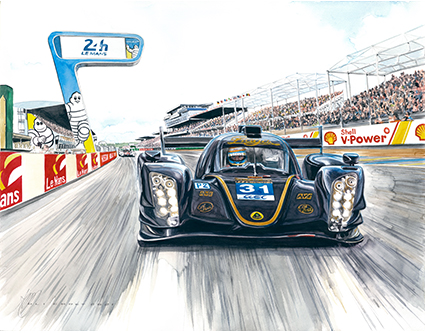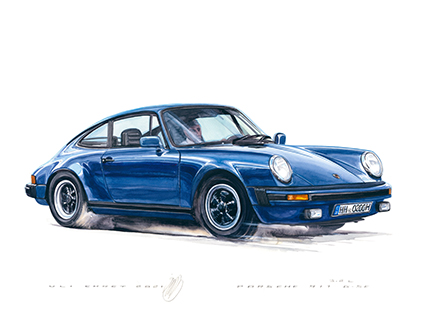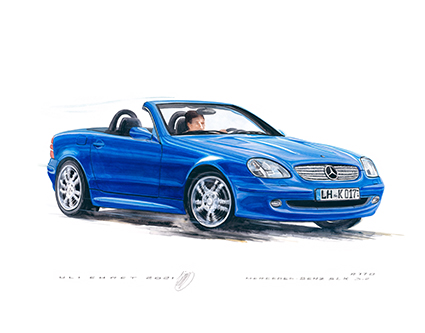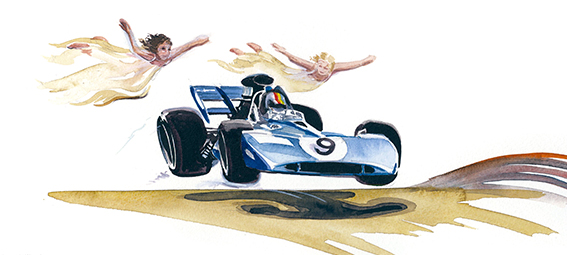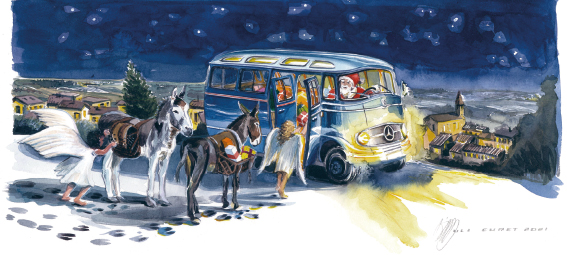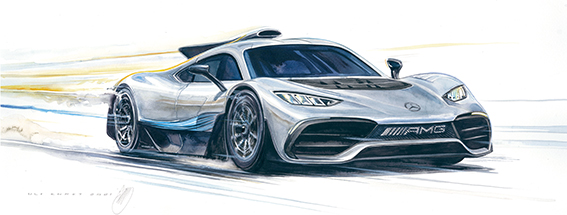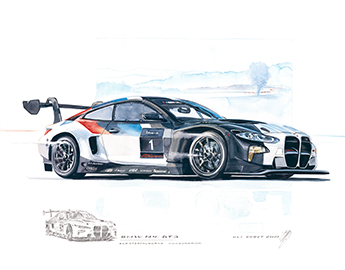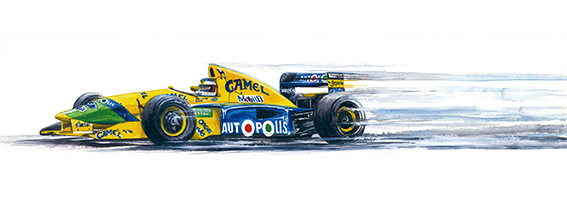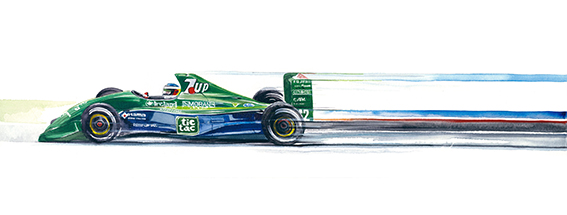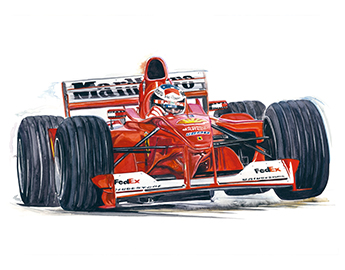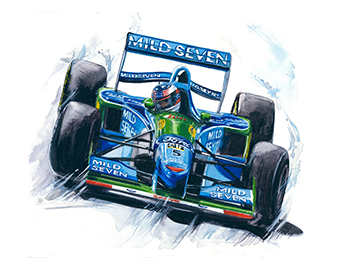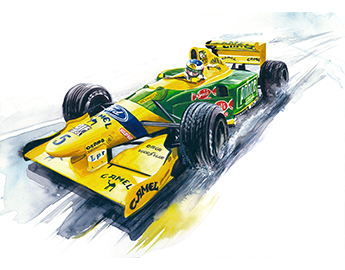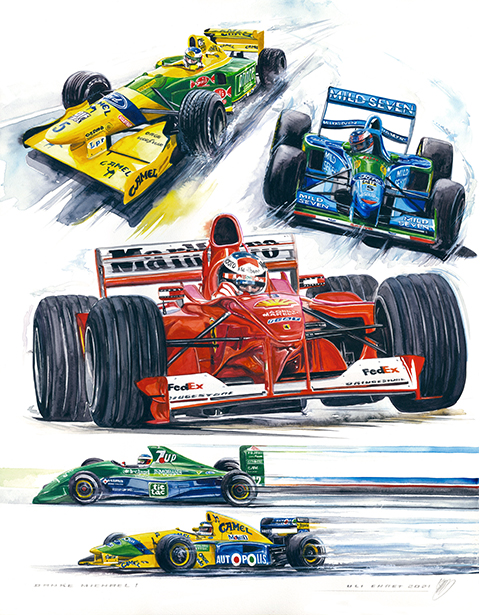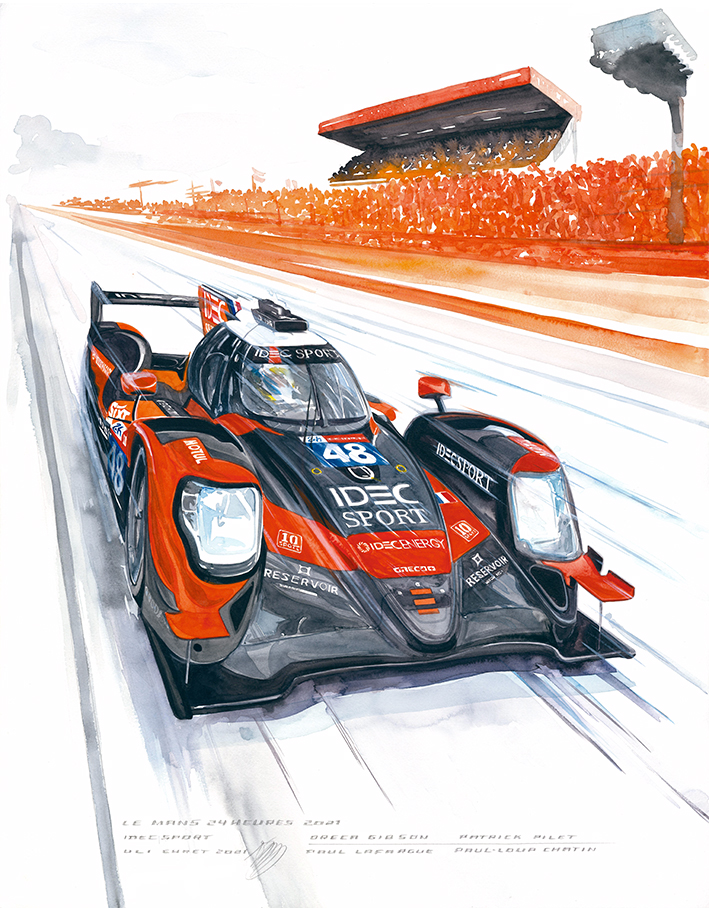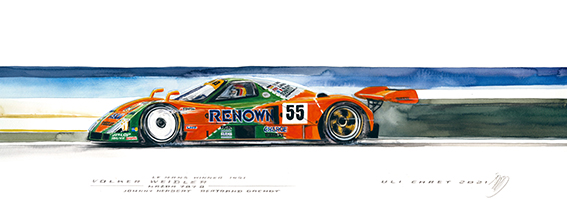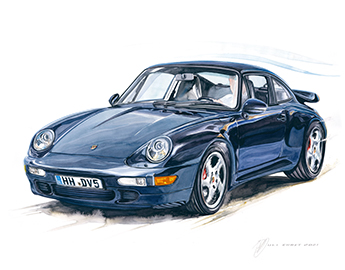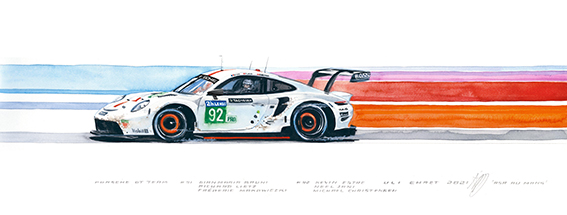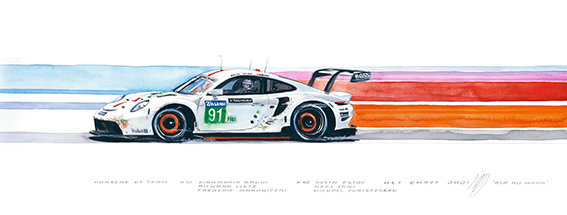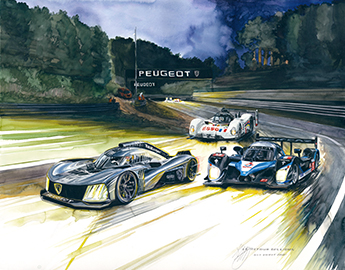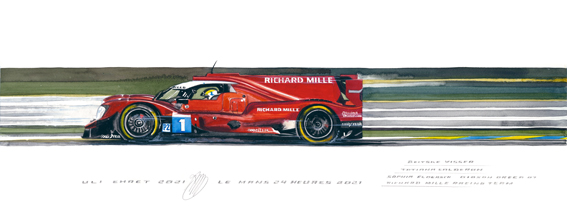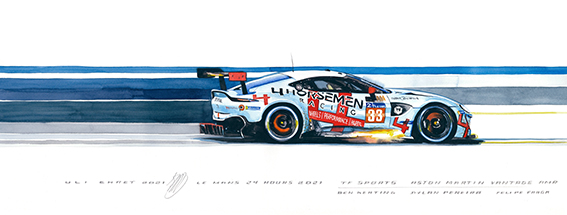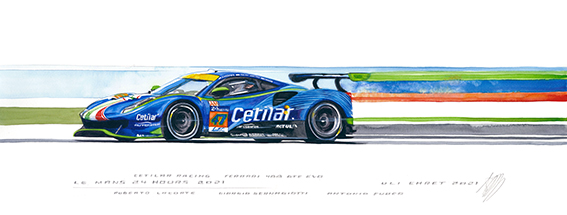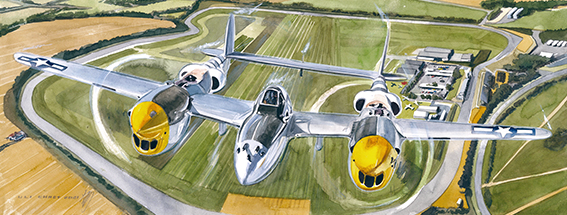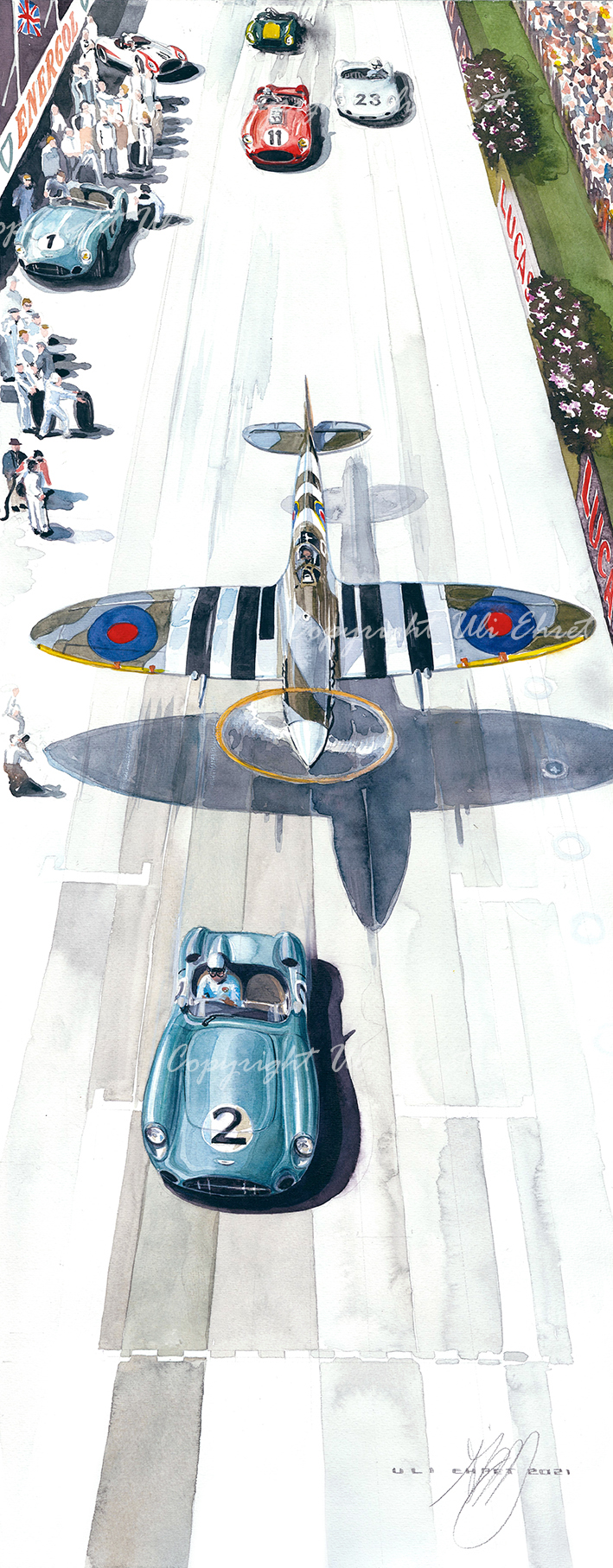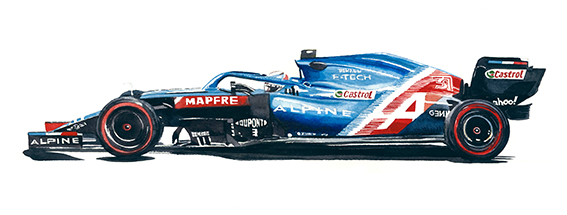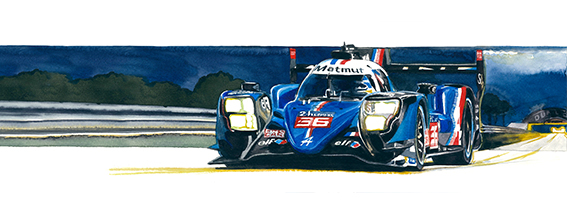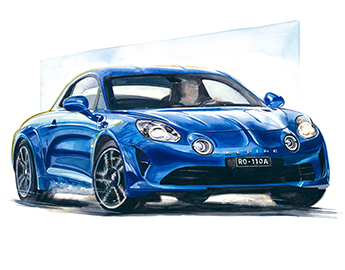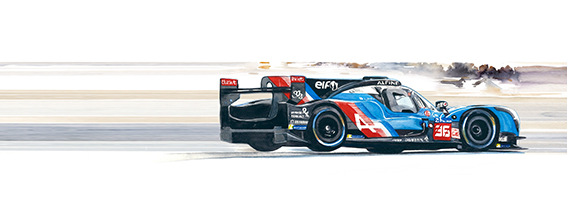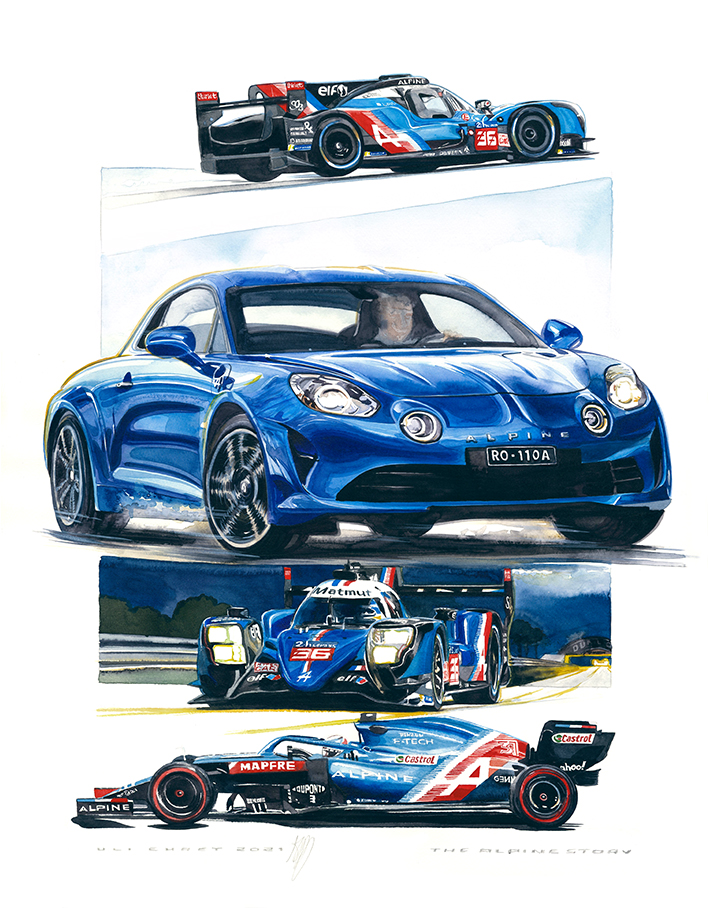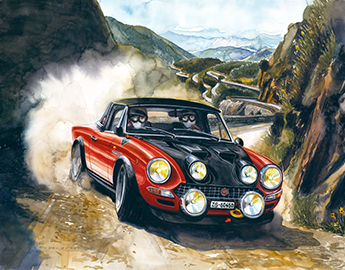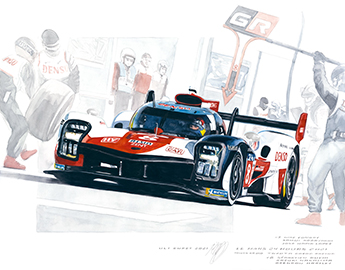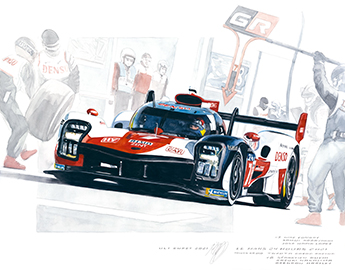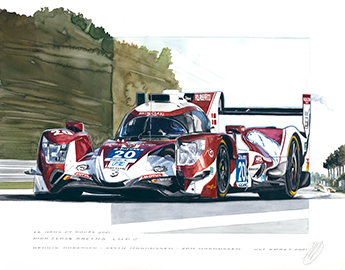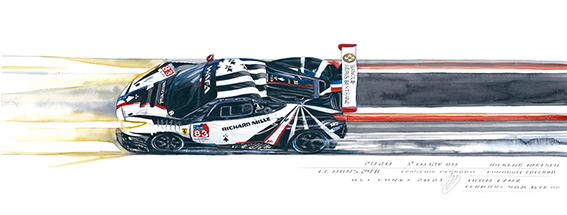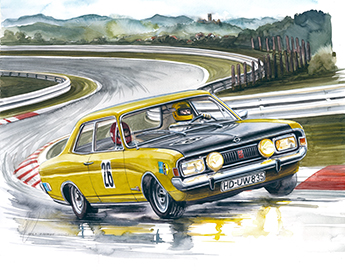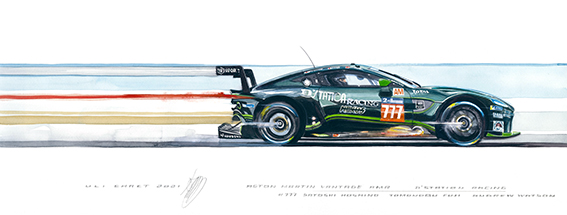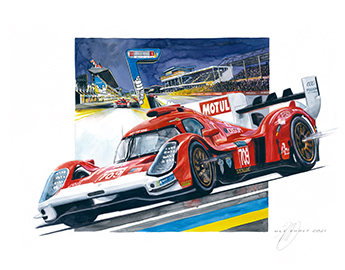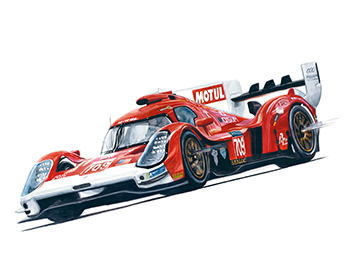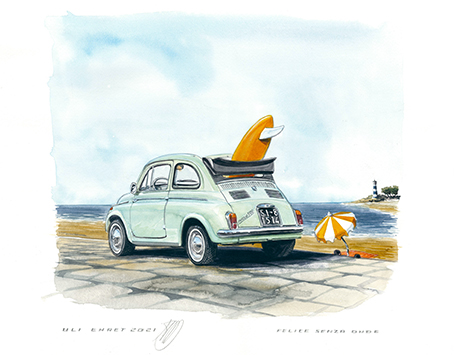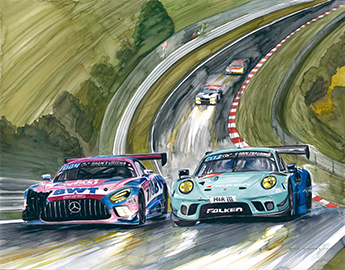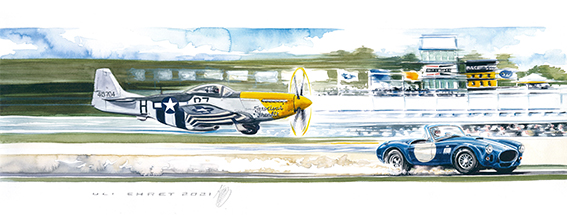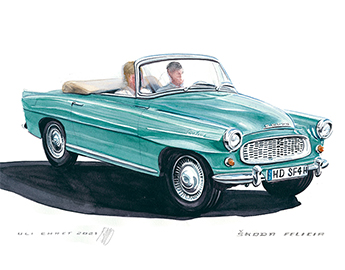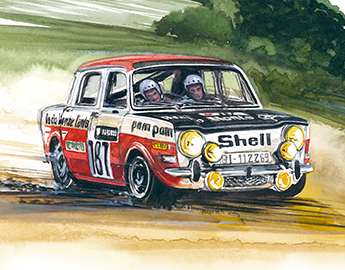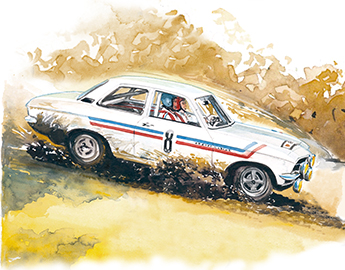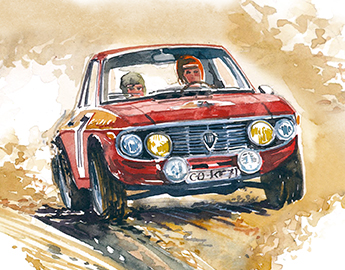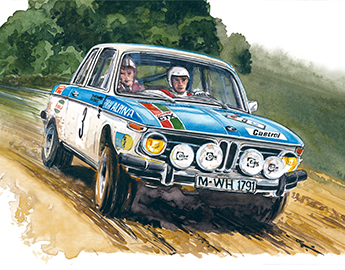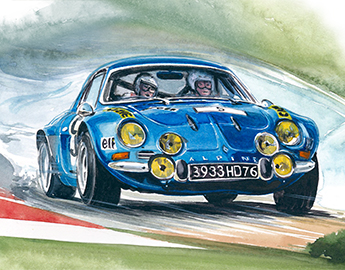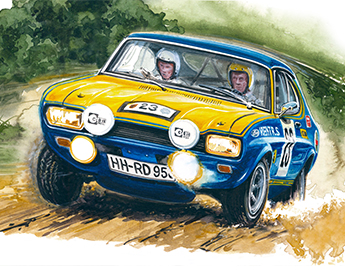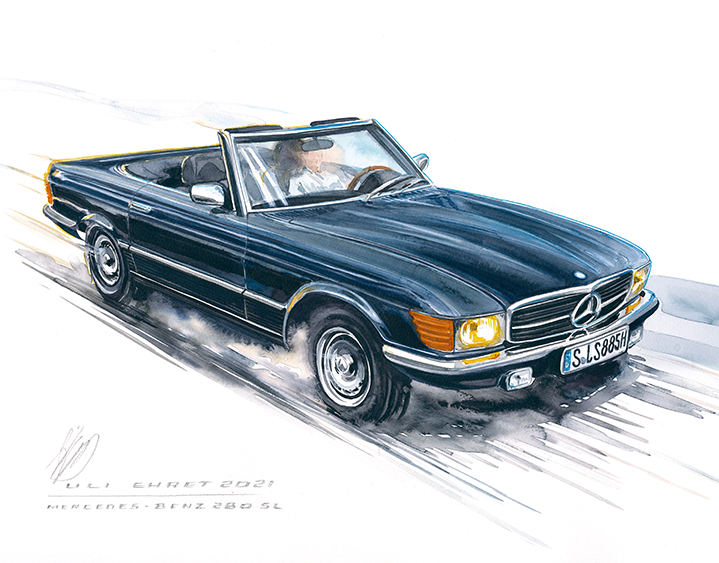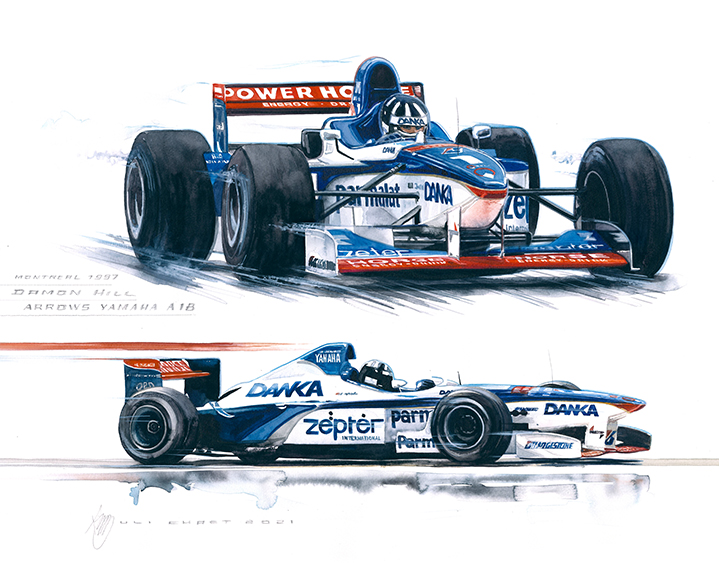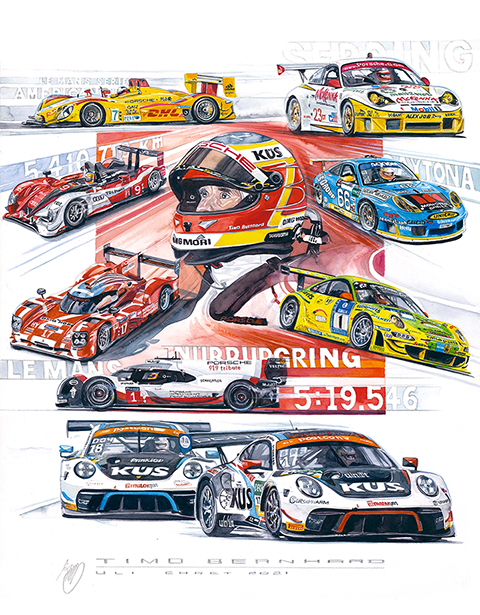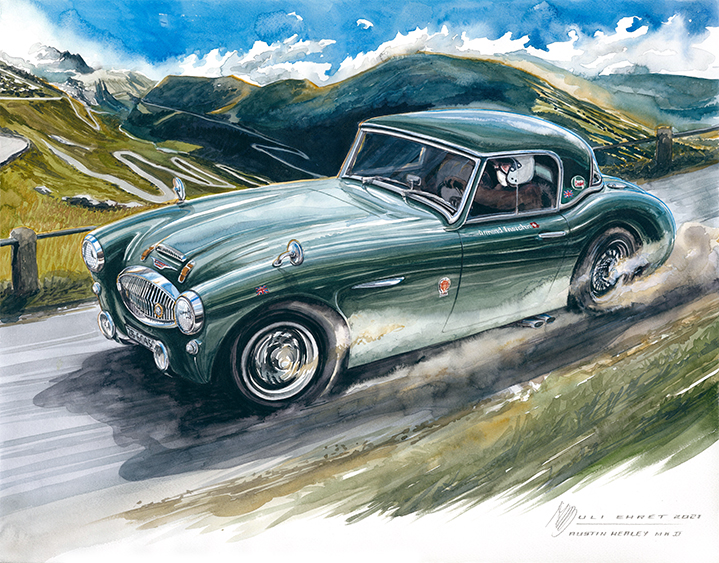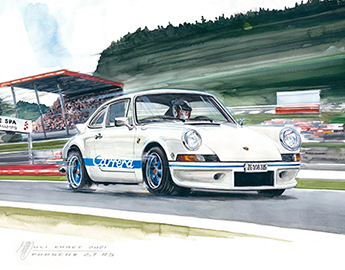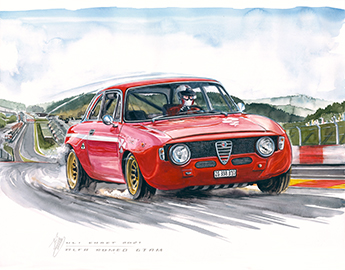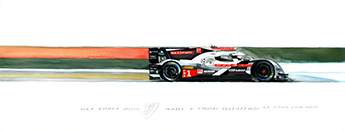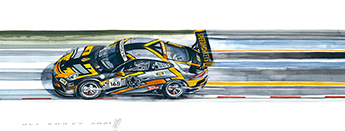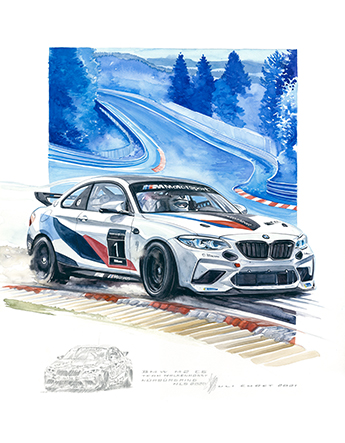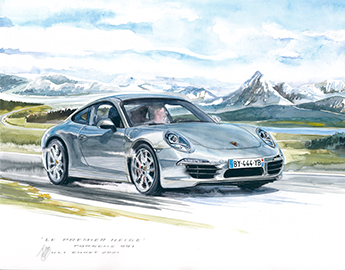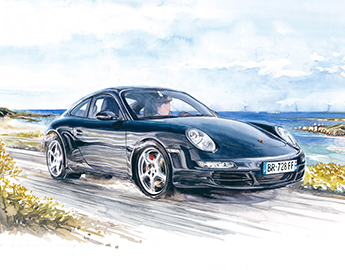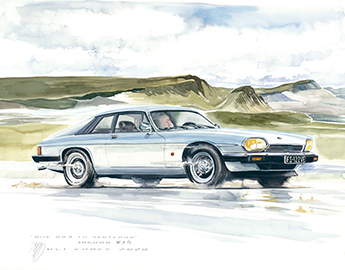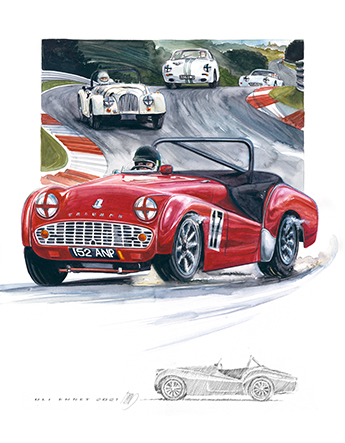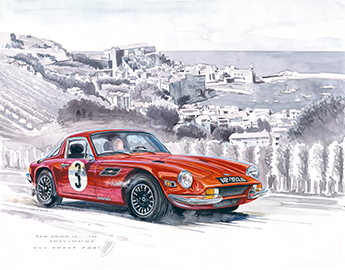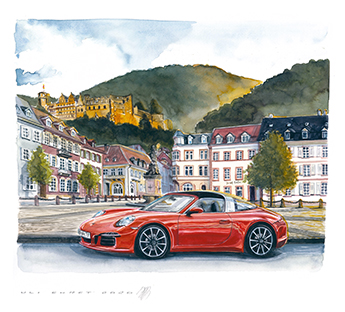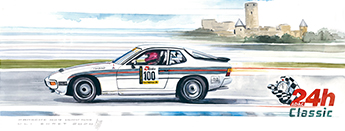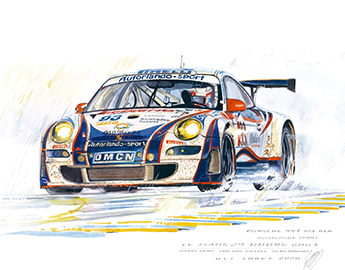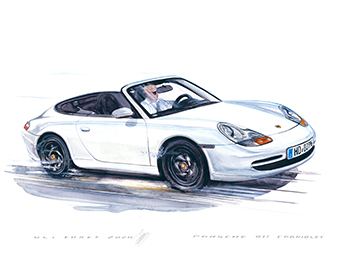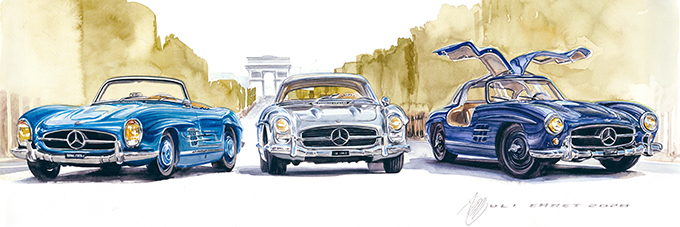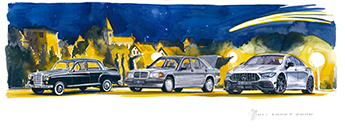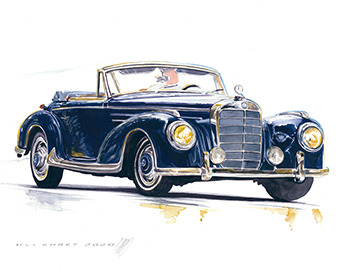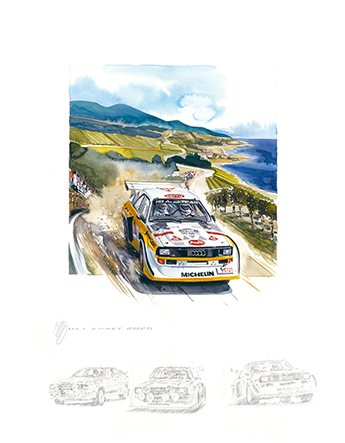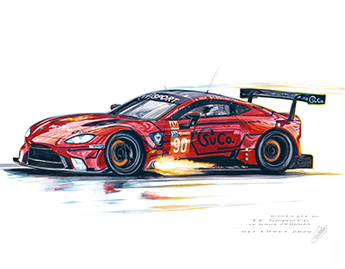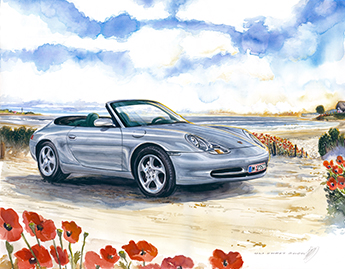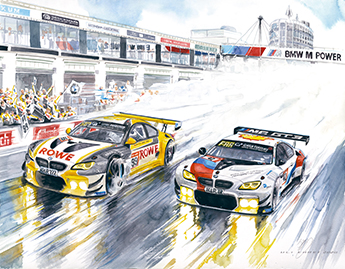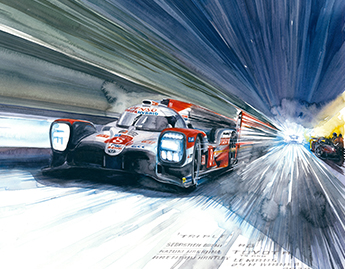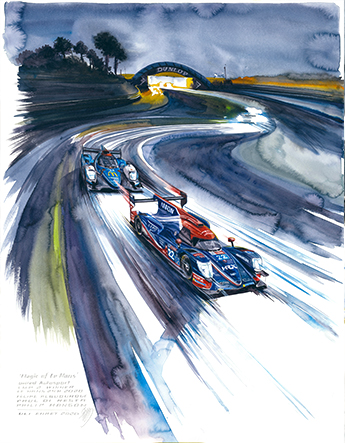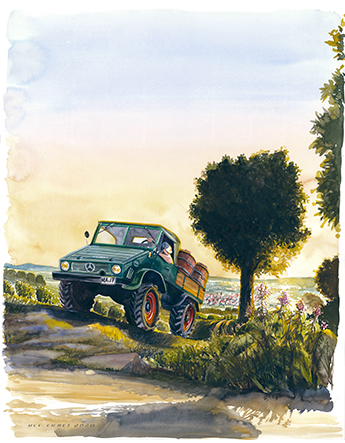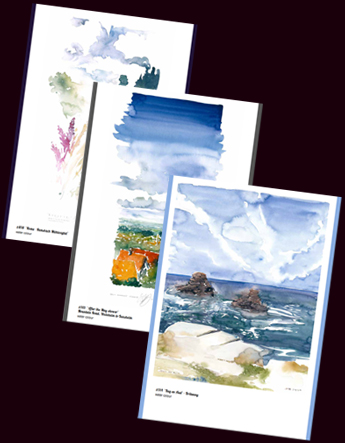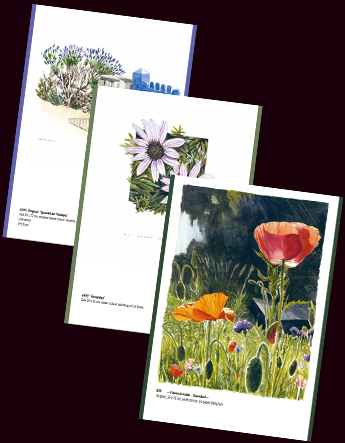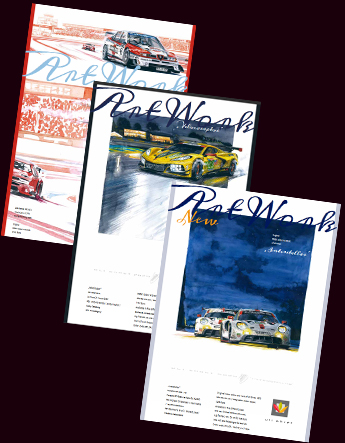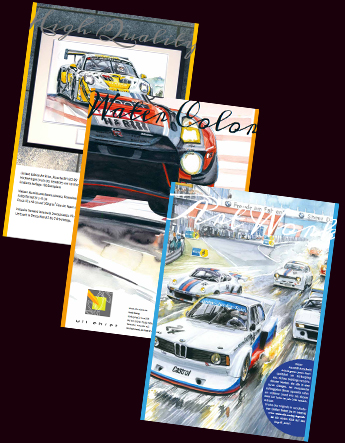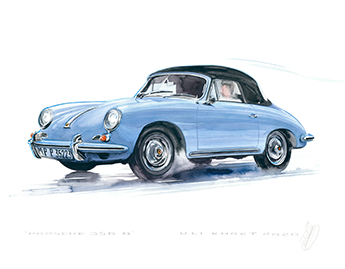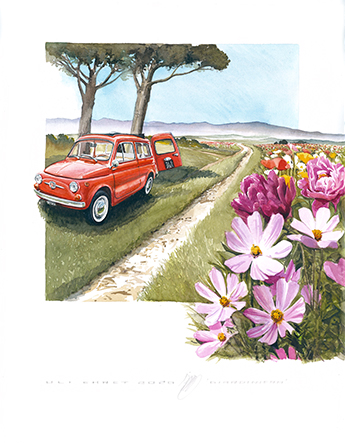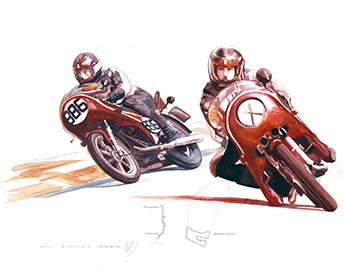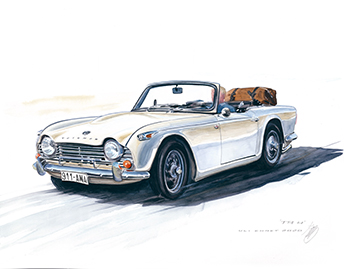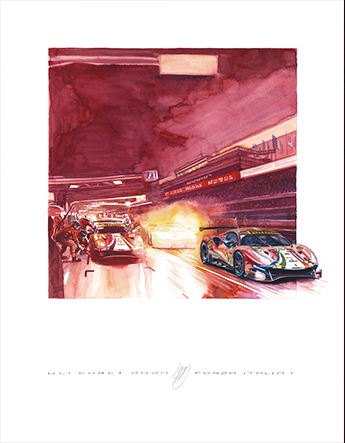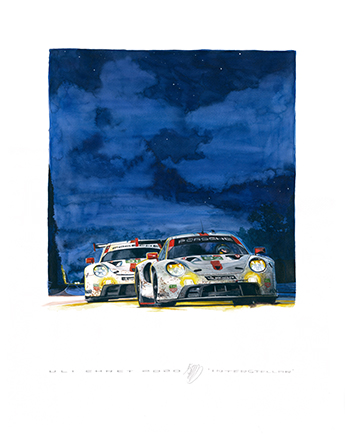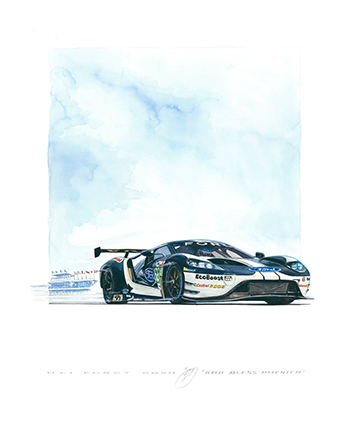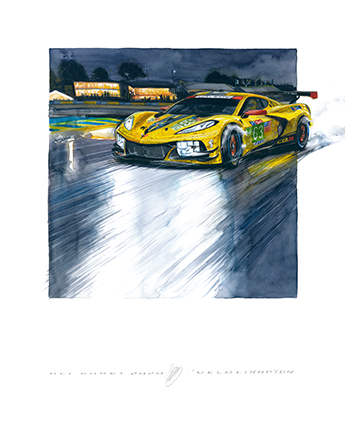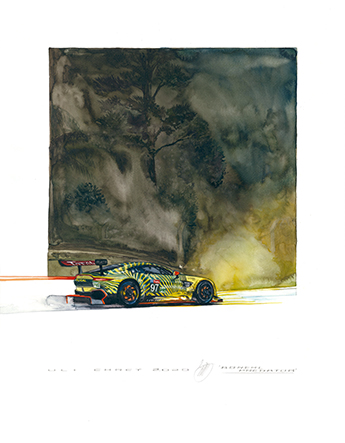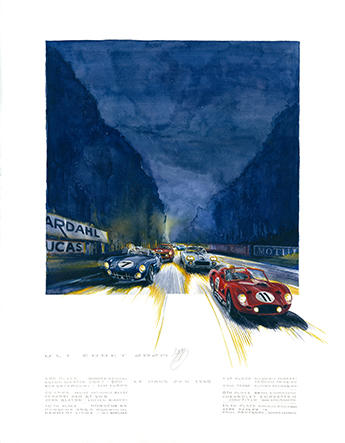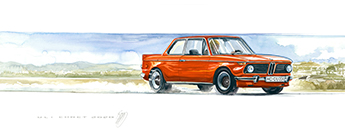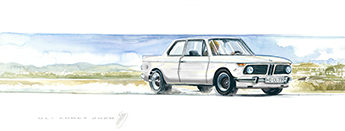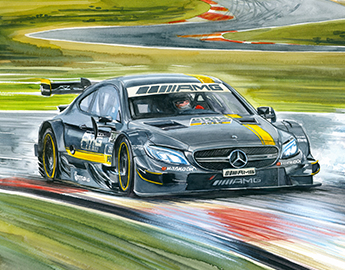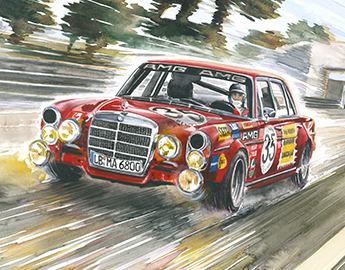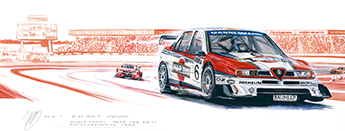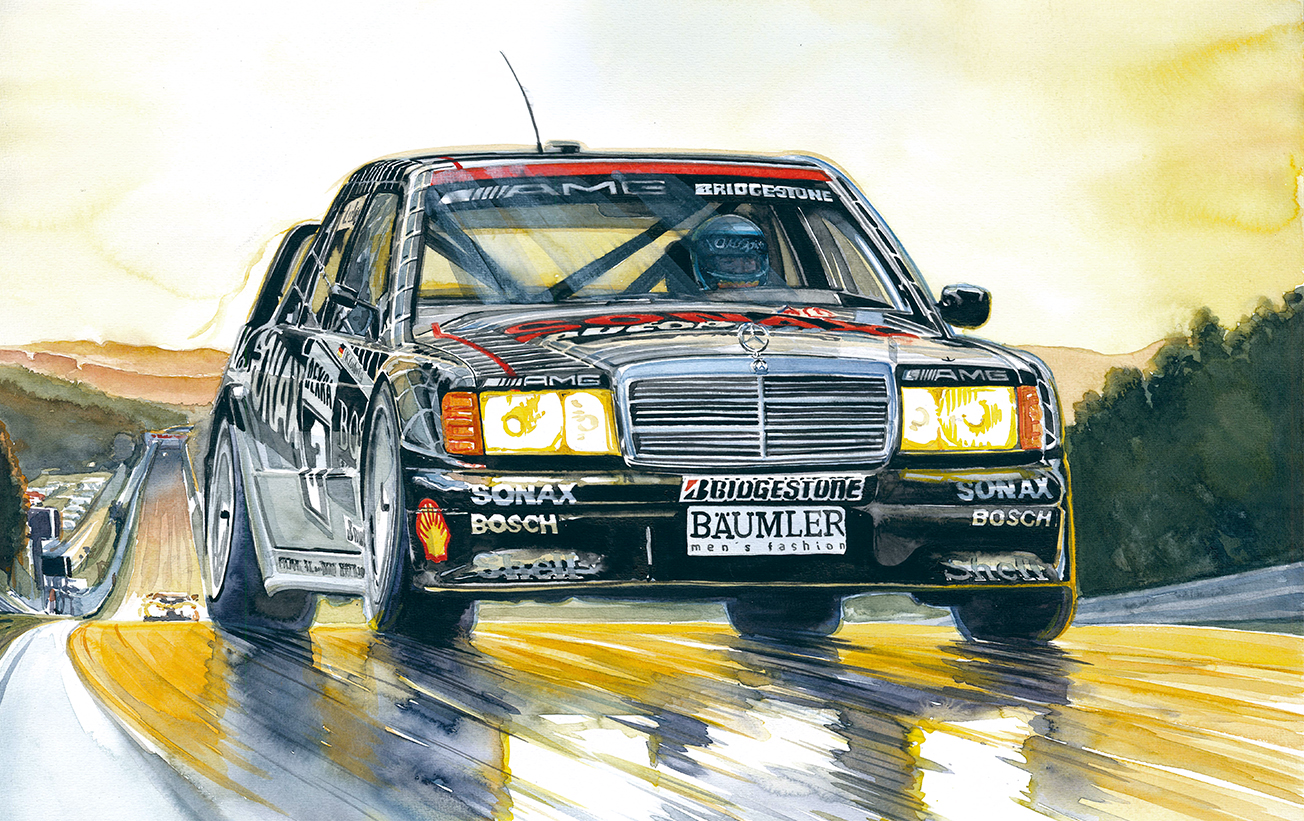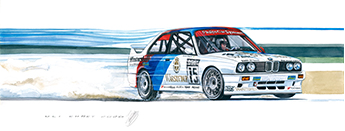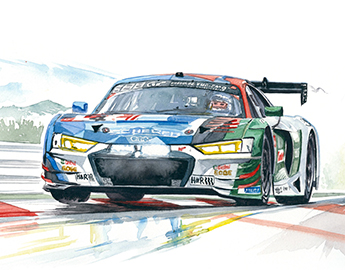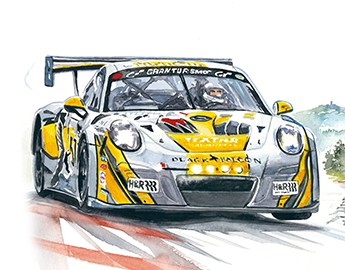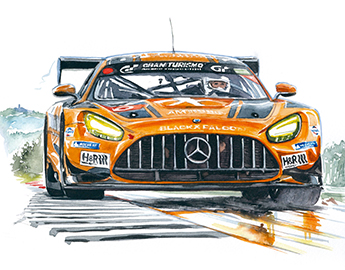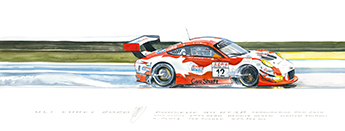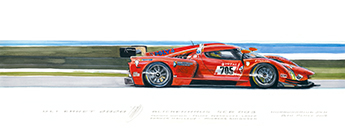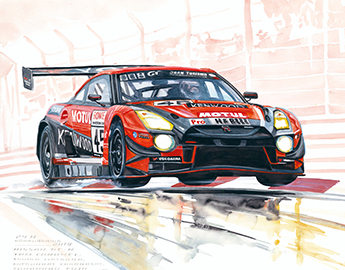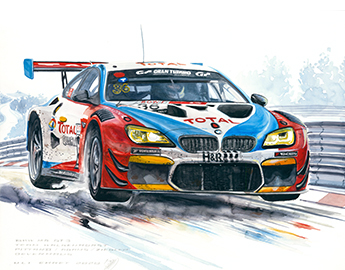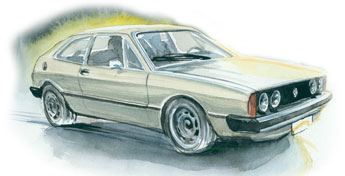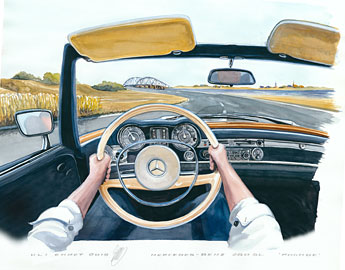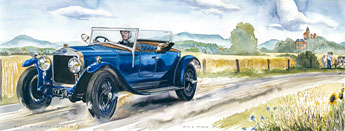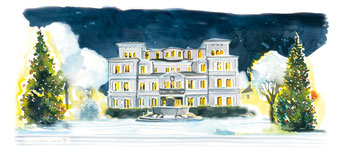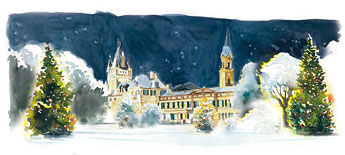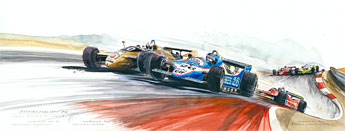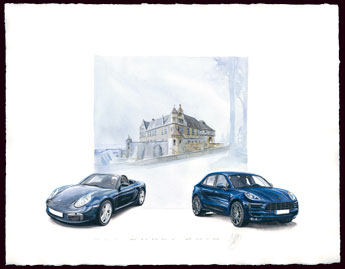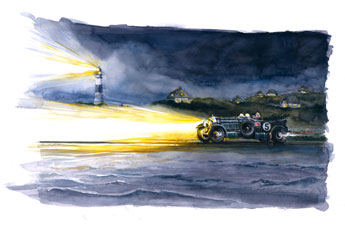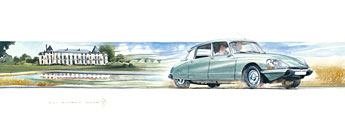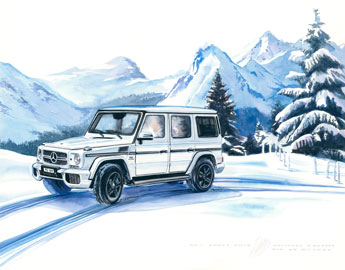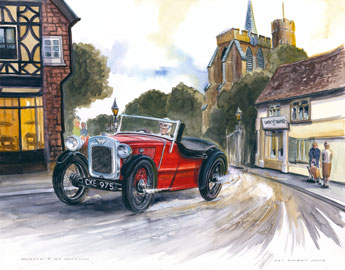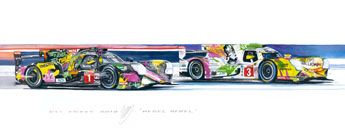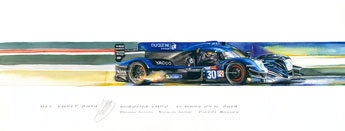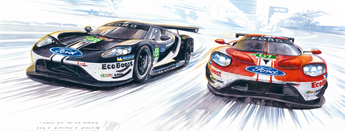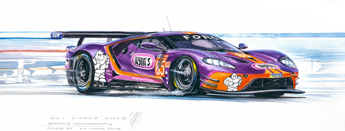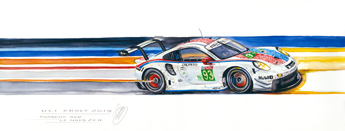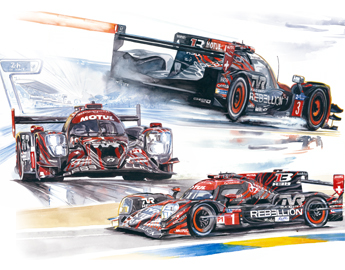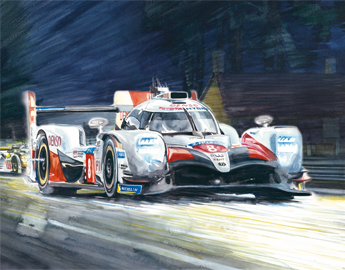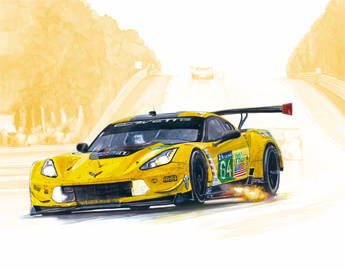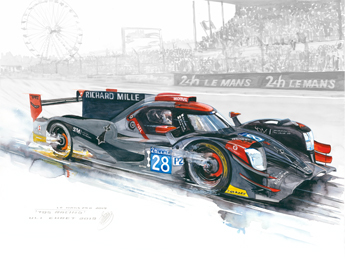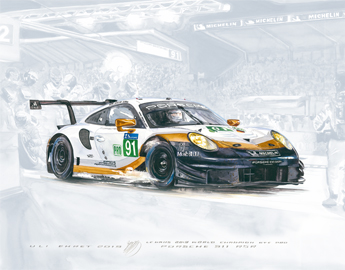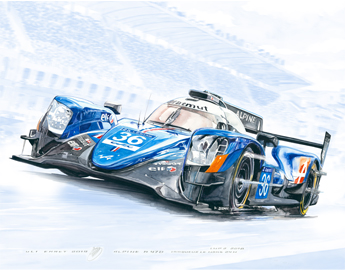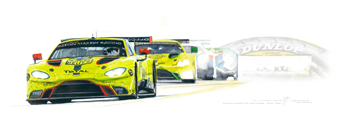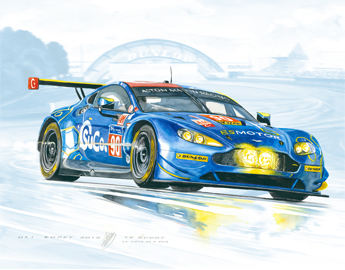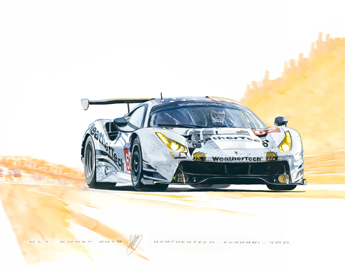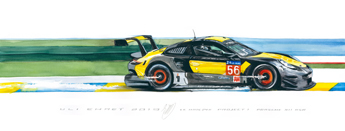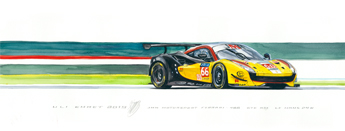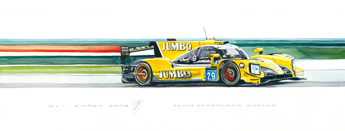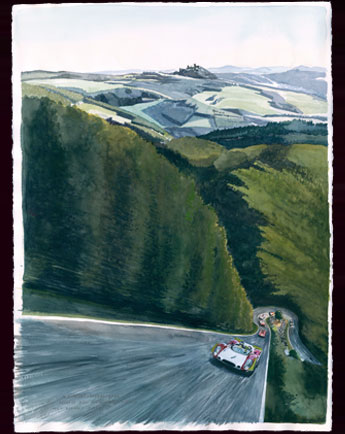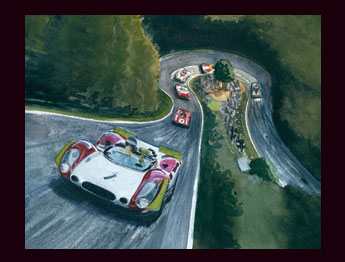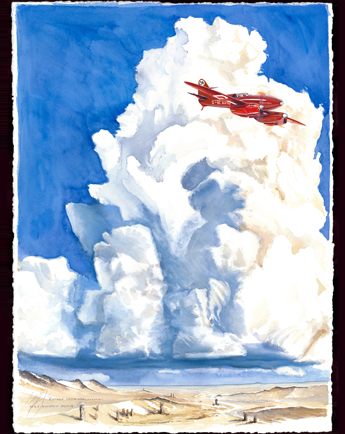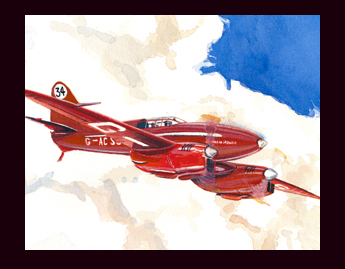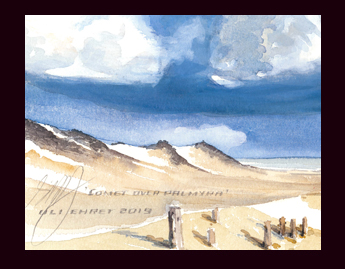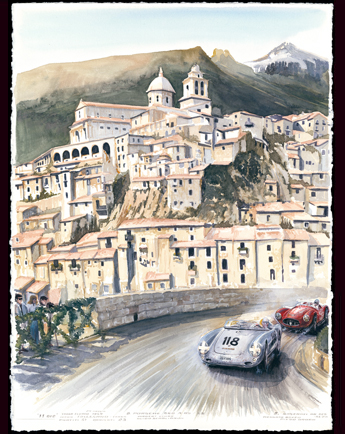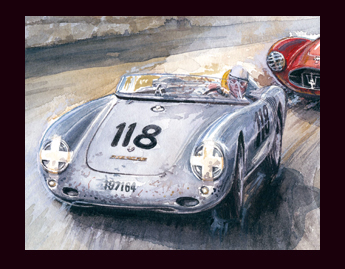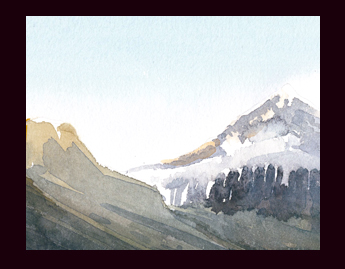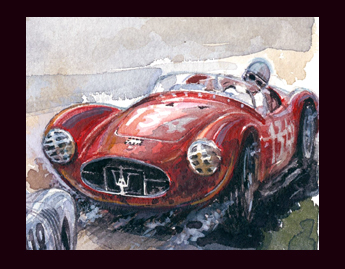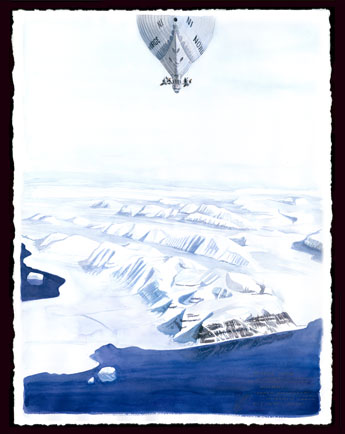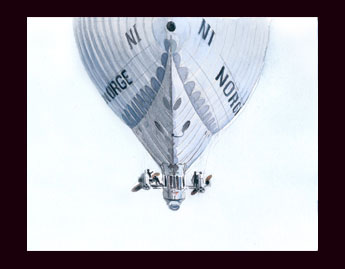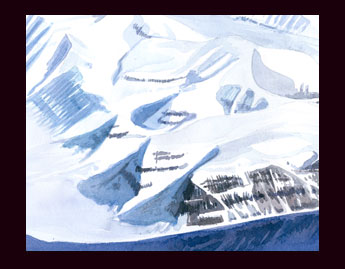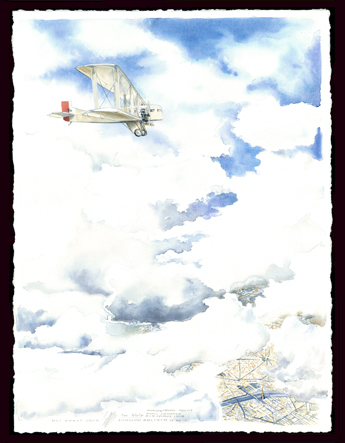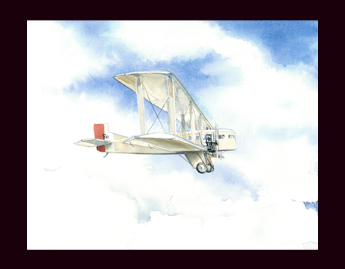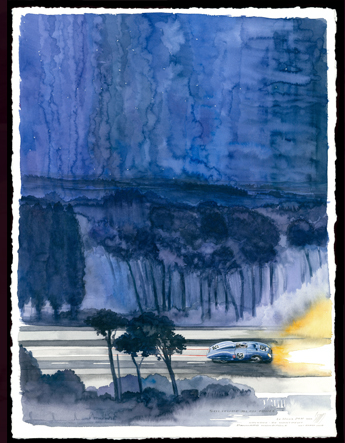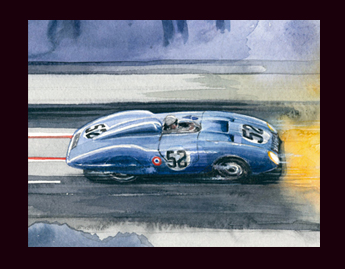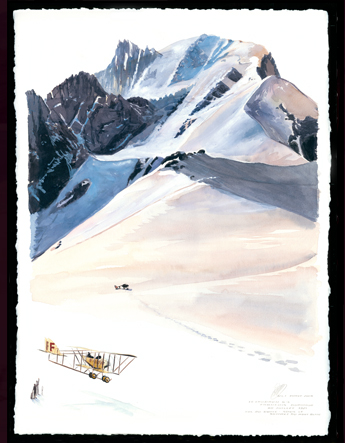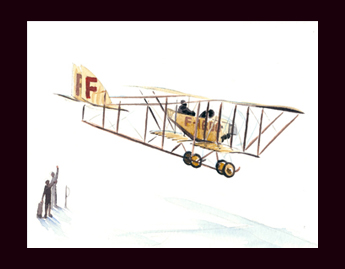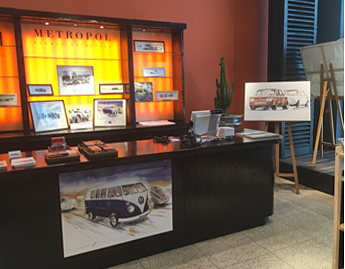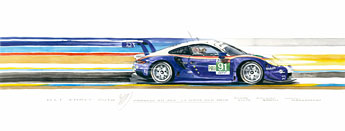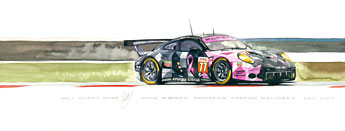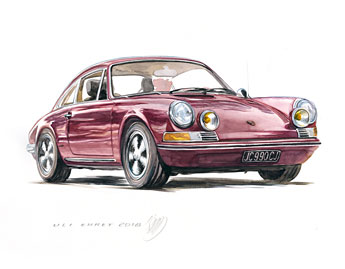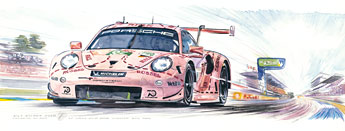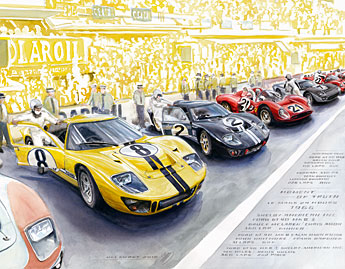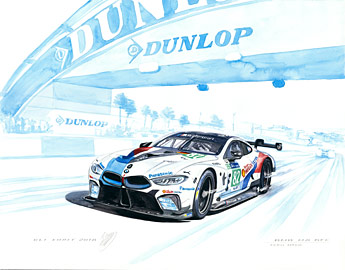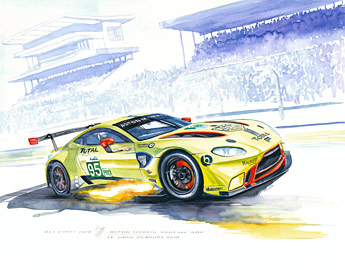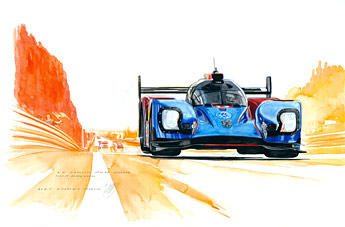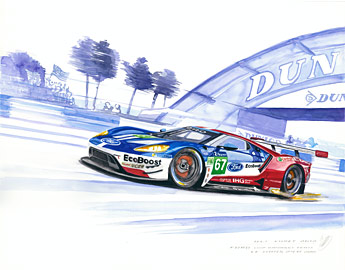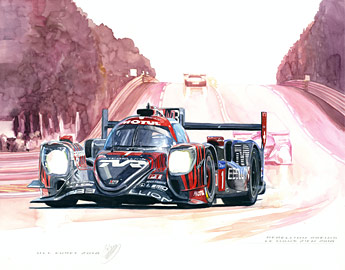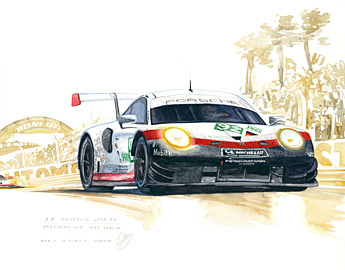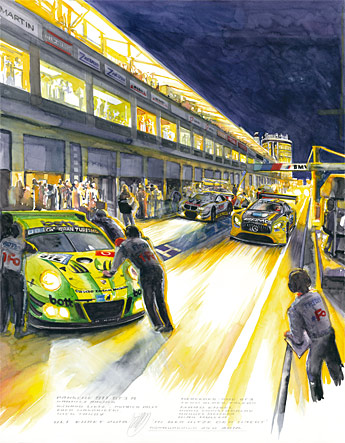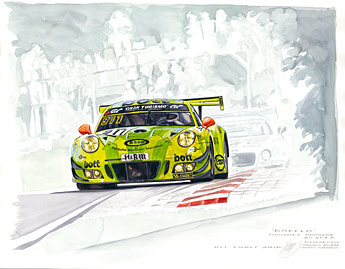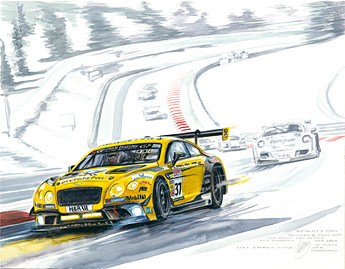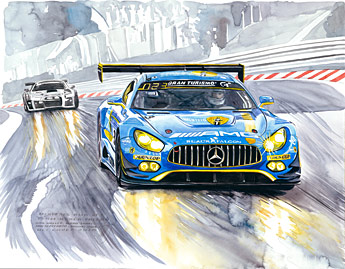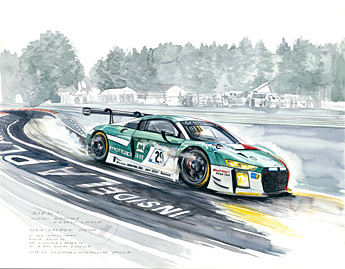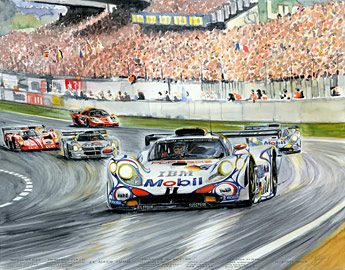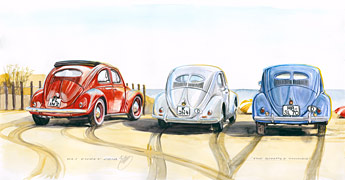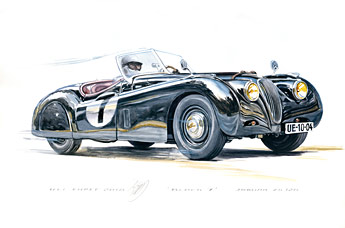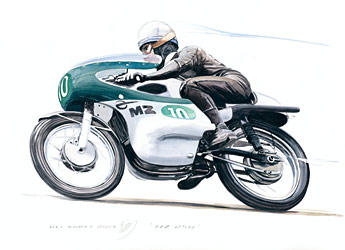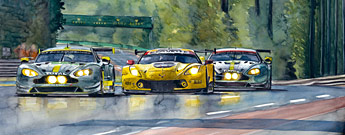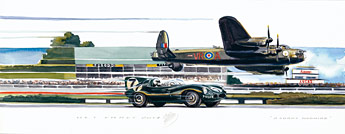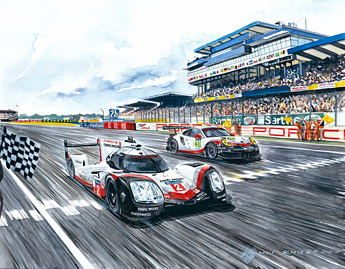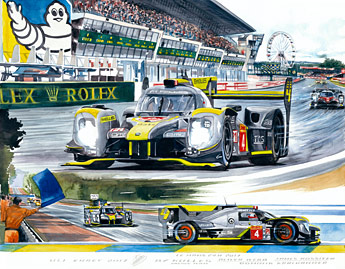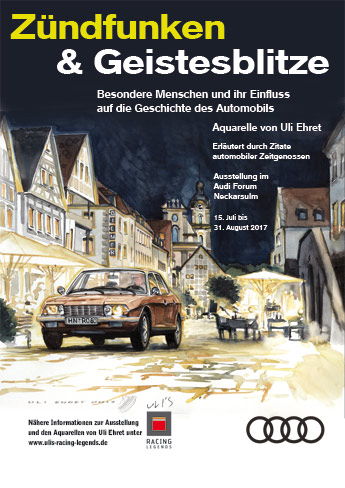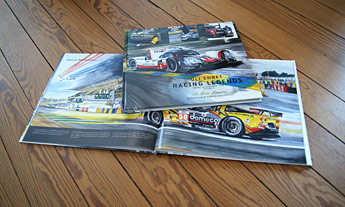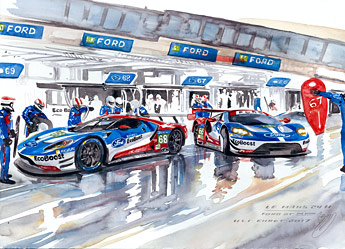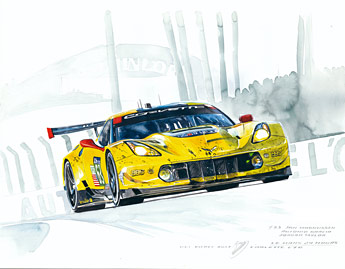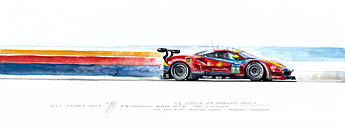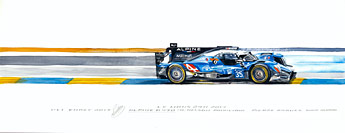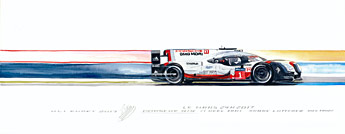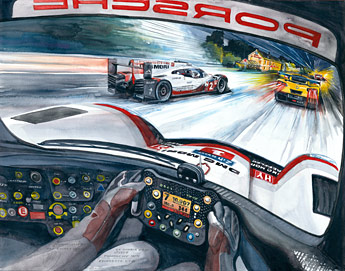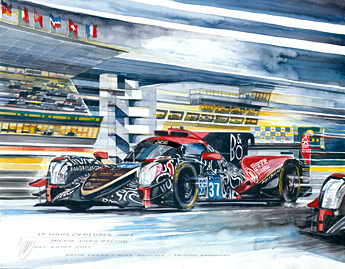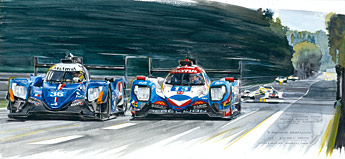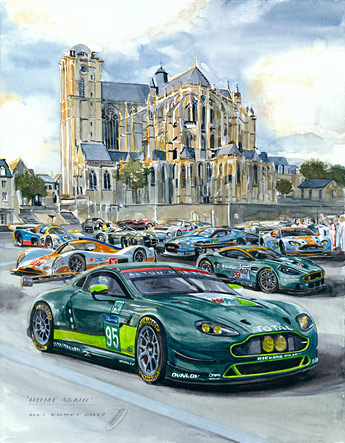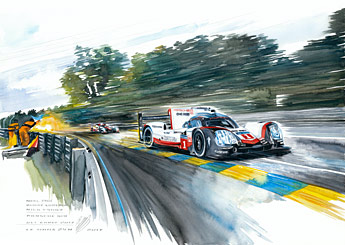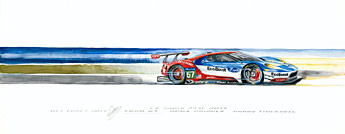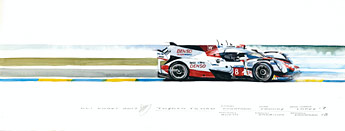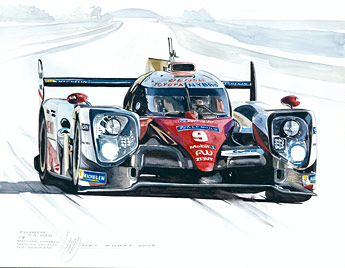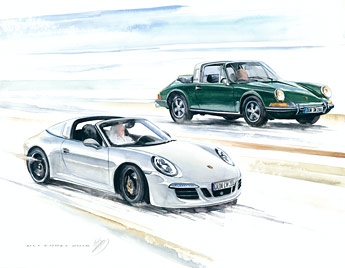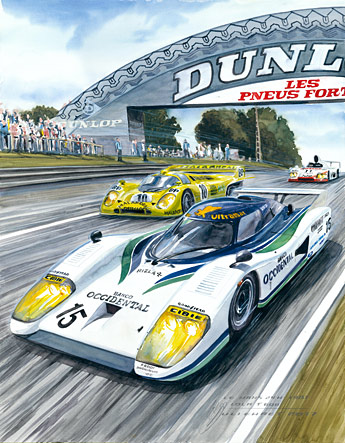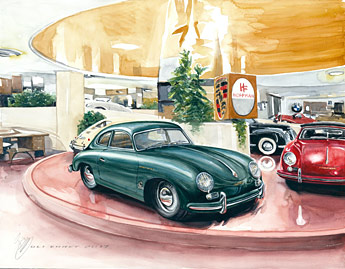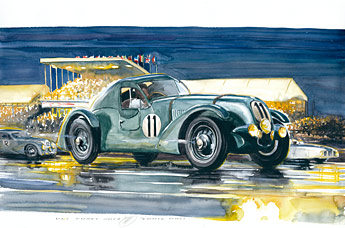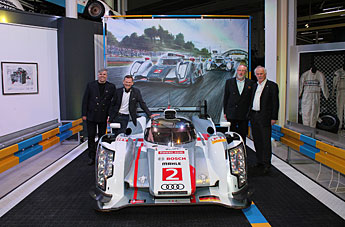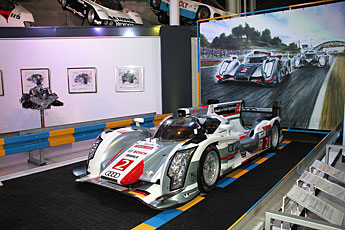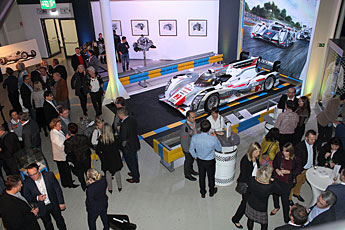|
#1007 Lotus LMP2
Le Mans 24 h, 2013
|
|
#1005 Porsche 911
G-SC 3.2 L Original: sold 50 x 64 cm
|
|
#1004 Mercedes Benz
SLK 3.2 R110 Original: sold 50 x 64 cm
|
|
Christmas Card 2021
Guardian Angels
|
|
Christmas Card 2021
Licht im Dunkel
|
|
#999 Mercedes AMR
|
|
#998 BMW M4 GT3
|
|
#993 E Michael Schumacher
Benetton B191 (F1 1991)
|
|
#993 D Michael Schumacher
Jordan Ford J191 (GP Belgium 1991)
|
|
#993 C Michael Schumacher
Ferrari F1 2000 (Kanada GP) |
|
#993 B Michael Schumacher
Benetton B194 (Australia 1994) |
|
#993 A Michael Schumacher
Benetton B193 (Kanada 1993) |
|
#993 Michael Schumacher
Benetton B193 (Kanada 1993) Benetton B194 (Australia 1994) Ferrari F1 2000 (Kanada GP) Jordan Ford J191 (GP Belgium 1991) Benetton B191 (F1 1991) Original 50 x 64 cm 2890 Euros |
|
#991 IDEC Sport
Le Mans 24 Hours 2021 Oreca Gibson Patrick Pilet Paul Lafargue Paul-Loup Chatin Original 50 x 64 cm 890 Euros |
|
#990 Mazda 787 B
Le Mans Winner 1991
Volker Weidler
|
|
#988 Porsche 911 Turbo
Baureihe 993
Original: 50 x 64 cm sold |
|
#987 B Porsche GT Team
RSR au Mans #92 Kévin Estre Neel Jani Michael Christensen
|
|
#987 A Porsche GT Team
RSR au Mans #91 Gianmaria Bruni Richard Lietz Fréderic Makowiecki Original: 25 x 64 cm 690 Euros |
|
#986 Le Retour des Lions
Peugeot 9x8 á Arnage Original: 50 x 64 cm 2890 Euros
|
|
#985 Richard Mille Racing
Le Mans 24 H 2021 Gibson Oreca 07 Beitske Visser Tatiana Calderón Sophia Flörsch Original: 25 x 64 cm sold
|
|
#984 Aston Martin Vantage AMR
Le Mans 24 H 2021 TF Sports Ben Keating Dylan Pereira Felipe Fraga Original: 25 x 64 cm sold
|
|
#983 Ferrari 488 GTE Evo
Le Mans 24H 2021
Original: 25 x 64 cm sold |
|
#982 Lockhead P38 Lightning
Goodwood Fly By
Original: 25 x 64 cm 1390 Euros |
|
#981 Stirling Moss & Spitfire
Original: 64 x 25 cm 1190 Euros |
|
#980 E Alpine Formel 1
#37 Esteban Ocon
|
|
#980 D Alpine A480 Hypercar
#36 Nicolas Lapierre Matthieu Vaxivière |
|
#980 C Alpine A110
|
|
#980 B Alpine A480 Hypercar
#36
|
|
#980 A „The Alpine Story“
Alpine A480 Hypercar #36 Nicolas Lapierre Matthieu Vaxivière Alpine F1 #37 Esteban Ocon Alpine A110 Original 50 x 64 cm 3290 Euros |
|
#979 Fiat Abarth 124 Rallye
Col de Turini Original sold 64 x 50 cm
|
|
#978 B Toyota GR 010
Le Mans 24 Hours 2021 TOYOTA GAZOO RACING #8 Sébastien Buemi Kazuki Nakajima Brendon Hartley
|
|
#978 A Toyota GR 010
Le Mans 24 Hours 2021 TOYOTA GAZOO RACING #7 Mike Conway Kamui Kobayashi José María López Original 990 € 64 x 50 cm
|
|
#977 High Class Racing, LMP2
Le Mans 24 Hours 2021 Oreca-Gibson 07 #20 Dennis Andersen Kevin Magnussen Jan Magnussen Original sold 64 x 50 cm
|
|
#976 AF Corse
Le Mans 24 H 2020 Ferrari 488 GTE EVO #83 François Perrodo Emmanuel Collard Nicklas Nielsen Original sold 25 x 64 cm
|
|
#975 Opel Commodore GS
Serie A, Osada/Osada 250 Meilen, Nürburgring 1977 Original sold 40 x 50 cm
|
|
#974 Aston Martin Vantage AMR
Team D’station #777, Le Mans 24 H 2021 Satoshi Hoshino (JPN) Tomonobo Fujii (JPN) Andrew Watson (GBR) Original sold 25 x 64 cm
|
|
#973 B Glickenhaus SCG 007 LMH
Scuderia Cameron Glickenhaus Le Mans 24 Hours 2021 #709 Romain Dumas (F) Richard Westbrook (GBR) Ryan Briscoe (USA) Original sold 64 x 50 cm
|
|
#973 A Glickenhaus SCG 007 LMH
Scuderia Cameron Glickenhaus
Le Mans 24 Hours 2021
#709
Romain Dumas (F)
Richard Westbrook (GBR)
Ryan Briscoe (USA)
Original 64 x 50 cm
|
|
#959 Felice senza onde
Fiat 500 Original sold 40 x 50 cm
|
|
#972 Mercedes, Porsche, Nürburgring 24h 2021
Marciello, Müller Original 990 € 64 x 50 cm |
|
#965 Mustang P51, AC Cobra 427
Goodwood Revival Original sold 64 x 25 cm |
|
#968 Škoda Felicia
Baujahr 1959 Original 390 € 40 x 20 cm |
|
#963 F Simca 1100 Rallye
Olympia Rallye 1972 Original sold 50 x 64 cm |
|
#963 E Opel Ascona SR
Olympia Rallye 1972 Original sold 50 x 64 cm |
|
#963 D Lancia Fulvia 1,6 HF
Olympia Rallye 1972 Original sold 50 x 64 cm |
|
#963 C Alpina BMW 2002 TI
Olympia Rallye 1972 Original sold 50 x 64 cm |
|
#963 B Renault Alpine A110
Olympia Rallye 1972 Original sold 50 x 64 cm |
|
#963 A Walter Röhrl, Ford Capri RS
Olympia Rallye 1972 Original sold 50 x 64 cm |
|
#962 Mercedes Benz 280 SL
Original sold 50 x 64 cm |
|
#961 Arrows A18
Damon Hill, Montreal 1997 Original 900 € 50 x 64 cm |
|
#957 Timo Bernhard 2021
Original sold 50 x 64 cm |
|
#956 Austin Healey, Mk II
Furka Pass Original sold 50 x 64 cm |
|
#955 Porsche RS
Spa-Francorchamps Original sold 50 x 64 cm |
|
#954 Alfa GTAM
Spa-Francorchamps Original sold 50 x 64 cm |
|
#953 Audi LMP1 eTron Quattro
#1 Winner 2014 Original sold 25 x 64 cm |
|
#952 Porsche 911
Porsche Sports Cup 2019 Original sold 25 x 64 cm |
|
#950 BMW M2 CS
Nürburgring NLS 2020 Original sold 64 x 50 cm |
|
#949 “Le Premier Neige”
Porsche 991 Original sold 50 x 64 cm |
|
#948 Porsche 997
911 en Finistère Porsche 997 Coupé Original sold 50 x 64 cm |
|
#947 One Day in Scotland
Jaguar XJS Original sold 50 x 64 cm |
|
#945 Triumph TR3
Original sold 50 x 64 cm |
|
#944 TVR 2500 M
Collioure / France Original sold 50 x 64 cm |
|
#943 911, Baureihe 911, Targa
Heidelberg, Kornmarkt Original sold 50 x 64 cm |
|
#942 Porsche 924
Laurent Rung Original sold 25 x 64 cm |
|
#941 Porsche 997 GT3 RSR
24 Hours of Le Mans 2007 Pierre Ehret Allan Simonsen Lars-Erik Nielsen 309 laps, overall 21 st place overall Second place in GT2
50 x 64 cm Original sold |
|
#938 Porsche 911 Cabriolet
Baureihe 996 Original sold 50 x 64 cm |
|
#935 Mercedes 300 SL “Grandezza”
Champs Elysée, Paris Original 890 € 25 x 64 cm |
|
#937 Mercedes Benz, CLA Coupé, 190, 180
“Sternstunde” Original 890 € 25 x 64 cm
|
|
#936 Mercedes 300 S Cabriolet Original 590 € 50 x 64 cm
|
|
#933 Audi S1 Quattro
San Remo Rallye 1984 Winner: Walter Röhrl Original 50 x 64 cm Original 1390 €
|
|
#932 TF Sport
Aston Martin AMR GTE AM Winner Le Mans 24h 2020 Jonathan Adam Charlie Eastwood Salih Yoluç Original 50 x 64 cm Original 990 €
|
|
#934 Porsche 996 Cabriolet am Nordseestrand
Original 50 x 64 cm sold€
|
|
#931 BMW M6 GT3
Nürburgring 24h Winner 2020 #99 Nick Catsburg, Alexander Sims, Nick Yelloly #42 Augusto Farfus, Jens Klingmann, Martin Tomczyk, Sheldon van der Linde Original 50 x 64 cm sold
|
|
#930 "Triple"
Toyota #8 TS050, LMP1 Winner 24h of Le Mans 2020 Sebastien Buemi, Kazuki Nakajima, Brendon Hartley 387 Laps
Original 50 x 64 cm 890 €
|
|
#927 "Magic of Le Mans"
United Autosports LMP2 Winner 2020 24h of Le Mans Filipe Albuquerque, Paul di Resta, Phil Hanson
Original 50 x 64 cm 1390 €
|
|
#925 "Valley of fruits"
Unimog |
|
Catalog Landscapes
23 Watercolor Landscape Motifs August 2020
|
|
Catalog Flowers
14 Watercolor Flowers Motifs August 2020
|
|
Catalog Le Mans
Watercolor Le Mans Motifs 2020
|
|
Catalog Nürburgring
Watercolor Nürburgring Motifs
|
|
#880 Porsche 356 B Cabriolet
Original 40 x 50 cm sold
|
|
#879 Fiat 500 "Giardiniera" Toscana
Original 52 x 66 cm 300g/m Aquarellpapier, Bütten
|
|
#874 Yamaha RD 250
Original sold
|
|
#873 Triumph TR4
Original sold
|
|
#872 Ferrari 488, Le Mans 24h
2019 Sieger GTE Pro
#51 James Calado Alessandro Pier Guidi Daniel Serra
Original, 50 x 64 cm
|
|
#870 „Interstellar“
Porsche 911 RSR – 19 Porsche GT-Team, Le Mans 24 h 2020
#92 Michael Christensen Kevin Estre Laurens Vanthoor
#91 Gianmaria Bruni Richard Lietz Frédéric Makowiecki
Original, 50 x 64 cm
|
|
#869 „God Bless America“
Ford GT #66, Le Mans 24 Hours 2019
6th place GTE Pro category 25th place overall
Stefan Mücke Olivier Pla Billy Johnson
Original, 50 x 64 cm
|
|
#867 Corvette C8.R
Le Mans 24 Hours 2020 GTE Pro Category
#63 Antonio Garcia Jordan Taylor Nicky Catsburg
Original, 50 x 64 cm
|
|
#865 Boreal Predator
Le Mans 24h 2020
#97 Harry Tincknell Alex Lynn Maxime Martin
Aquarell, 50 x 64 cm
|
|
#863 „Le Mans 24 Hours 1960“
Ferrari Testa Rossa 59/60, Scuderia Ferrari #11 Paul Frère / Olivier Gendebien 1st place overall Aston Martin DBR1 / 300, Border Reivers #7 Jim Clark / Roy Salvadori, 3rd place overall
Chevrolet Corvette (C2), Briggs S. Cunningham #3 John Fitch / Bob Grossman 8th place overall, winner 5 liter category
Ferrari 250 GT SWB, Équipe Nationale Belge #21 Jean Blaton / Lucien Bianchi DNF, 29 laps
DB HBR4, Automobiles Deutsch & Bonet #48 Paul Armagnac / Gérard Laureau 15th place overall, winner 850 ccm category
Porsche 356 B Abarth GTL, Porsche KG #35 Herbert Linge / Hans-Joachim Walter 10th place overall winner 1.6 liter category
Original , 56 x 76 cm
|
|
#871 A BMW 2002 ti (orange)
Original sold
|
|
#871 B BMW 2002 ti (white)
Original sold |
|
#585 Mercedes AMG C63 Coupé – DTM Edition
Original sold to AMG
|
|
#864 AMG Mercedes Rote Sau
|
|
#860 Alfa 155 V6TI
Martini Alfa Corse Hockenheimring 1996 #6 Nicola Larini |
|
#859 AMG-Mercedes 190 E 2.5 – 16 Evolution II
AMG Motorsport Sieger der DTM-Läufe am Nürburgring am 18. Juni 1992 Meister der DTM 1992: Klaus Ludwig |
|
#858 BMW M3 E30
Team Schnitzer Nürburgring 24 Hours 1989 winner #15 Roberto Ravaglia / Emanuelle Pirro / Fabien Giroix 143 laps, DTM Champion 1989, #15 Roberto Ravaglia |
|
#853 Audi R8 LMS
Audi Sport Team Phoenix Nürburgring 24 Hours 2019 #4, Pierre Kaffer / Frank Stippler / Frederic Verdisch / Dries Vanthoor winner overall, 1st Place SP-9 category
|
|
#852 Porsche 991 GT3 Cup MRII
Black Falcon Team Textar Nürburgring VLN Lauf 3, 2019 #57, Peter Ludwig / Manuel Metzger / “Takis” 3rd Place SP-7
|
|
#851 Mercedes AMG GT3
Black Falcon Team Auto Arena Motorsport Nürburgring ADAC Barbarossapreis, 12. 10. 2019 #6, Patrick Assenheimer / Manuel Metzger 3rd Place SP-9 Category
|
|
#850 Porsche 911 GT3 R
Manthey Racing Nürburgring 24 Hours 2019 #12, Otto Klohs / Lars Kern / Dennis Olsen / Matteo Cairoli 4th place overall, 4th place in SP-9 category
|
|
#849 Glickenhaus SCG003C
Scuderia Cameron Glickenhaus Nürburgring 24 Hours 2019 #705, Thomas Mutsch / Felipe Fernandez-Laser / Franck Mailleux / Andreas Simonsen 8th Place Overall, 1st Place SP-X category
|
|
#848 Nissan GT-R Nismo GT3
Kondo Racing Nürburgring 24 Hours 2019 #45 Tom Coronel /Tsuigo Matsuda / Mitsunori Takaboshi / Tomunobu Fujii 9th Place Overall, 8th Place SP-8 category
|
|
#847 BMW M6 GT3
Team Walkenhorst #36 VLN Nürburgring David Pittard
|
|
#843 Volkswagen Scirocco
Für die menschlichen Baujahre der 60er ist er ein bekannter Begleiter ihrer Jugend: der VW Scirocco. Dieser Volkswagen zeigt ein wenig mehr Sportlichkeit, nach den Erfolgen mit den Käfern und Golf-Modellen, die Massen eher gemütlich von A nach B bewegten. Die schöne und simple Karosserie des Scirocco zeigt die zeitlose Eleganz, die auch kantige Designs der frühen 70er Jahre widerspiegeln können. Der Scirocco stand den X1-9, Stratos und Esprits dieser Design-Welt in nichts nach. Er war vielleicht nicht so aufregend wie der Lancia oder der Lotus, aber er hatte ein ganz unverwechselbares Erscheinungsbild. |
|
#842 Mercedes Benz 280 SL „Pagode“
Dieser Nordsee-Tourist steuert seinen wundervollen 280 SL geradewegs auf eine paradiesische Nordseeinsel zu. Wie immer in den späten sechziger Jahren, ist die Straße staufrei und von wenig Verkehr gezeichnet. Als Autofahren noch ein Vergnügen war und ein Mercedes-Benz ein handgebautes, hochkarätiges Edelgefährt höchster Güte. Das Aquarell von Uli Ehret soll diese Eroberung der Freiheit und die Faszination handgemachter Individualität ausdrücken: Nicht irgendein Wagen, sondern ein Mercedes. |
|
#841 Delage Di à l´Alsace en eté avant la Haut-Koenigsbourg
Le Delage Di bleu royale avant le chateu de Haut-Koenigsbourg en Alsace. L´été en Alsace est très chaud, a cause du climat continentale et du vallée du rhin. Le << Oberrhein >> ou haut-rhin en francais, passe les deux haut montagnes du fôret noir en est et les montagnes de l´Alsace en ouest L´Alsace avec ces vignobles et les montagnes entre 800 m et 1100 mètres hauteur est une région avec beaucoup des fruits et de la vegetation riche. Les montagnes du forêt noir avec leur hauteur de 1300 et 1400 m sont également dans l´interêt des visiteurs touristique qui aime les deux, la France et l´Allemagne. Comme ce touriste avec son Delage Di, peints par Uli Ehret en aquarelle, pour son ami Eric. |
|
#839 Hemsbacher Schloss at Christmas time
The Hemsbacher Schloss was built in the 18th century for a German merchand who loved Italy and the Italian styled villas. He helped to found a strong economical relationship between Italy and Germany in the 18th century. Today the Hemsbacher Schloss hosts the town majors office and town organization staff. Uli Ehret was born in Hemsbach in 1965. |
|
#838 Weinheimer Schloss at Christmas time
The Weinheim castle was build in the 18th century. It was home to the Graf von Berckheim, who was addicted to racing. He accompanied the Porsche team to Argentina in the early 50s to race the Carrera Panamericana and its 11.000 kms from north to south of the South American continent. The water colour painting shows the castle in snow and surrounded by beautiful Christmas trees at a December night. |
|
#837 Ligier JS 11 – Jacques Laffite at Zandvoort GP 1979
Jochen Mass in the Arrows and Jacques Laffite in the Ligier fought a F1 battle at Zandvoort during the Dutch GP in 1979, Followed by Gilles Villeneuve in the Ferrari 312 and René Arnoux in the Renault RS10 and Niki Lauda in the Brabham, this pictures shows the wonderful variety of F1 cars, constructions and engines in the late 70s. Though all Formula one cars were so different, the races were exciting and unpredictable. Jody Scheckter won the race at the dutch seaside and the championship in 1979. |
|
#835 Porsche Boxster und Macan vor Burg Stettenfels
Burg Stettenfels liegt in der Region Heilbronn. Das leichtblaue Quadrat bildet den optimalen Hintergrund für den schwarzen Boxster und den dunkelblauen Macan. Die Burg verleiht den beiden Porsche einen würdigen Hintergrund. |
|
#834 Bentley at the Beach
A Bentley Blower driving into the night on a coast line in Northern Europe. |
|
#833 Citroën DS avant Rueil-Malmaison
Rueil Malmaison is the place where the Citroën DS and many other Citroën cars are built.
|
#831 Mercedes G-Klasse AMG VB Biturbo
#829 Austin 7 at Hitchin
#824 Rebel Rebel
#819 Duqueine LMP 2, Le Mans 2019
#813 Ford GT at Le Mans 24 h 2019
#812 Keating Motorsports, Ford GT, Le Mans 24 h 2019
#811 Porsche RSR, Le Mans 24 h 2019
#809 Rebellion Racing, Le Mans 24 H, 2019
#808 Toyota TS050, 2019, World Champion LMP1
#806 Corvette C7R, Le Mans 24 H 2019
#805 TDS Racing, WEC
#804 Porsche 911 RSR, Le Mans 24 H 2019
#803 Alpine A 470, Vainqueur LMP2 Le Mans 24h 2018
#802 Aston Martin Vantage GTE PRO
#801 Larbre Competition, Ligier LMP2, Le Mans 24 h 2019
#800 Aston Martin V8, TF Sport, Le Mans 24h
#799 Ferrari 488, WeatherTech
#798 Porsche 911, RSR Project 1, Le Mans 24h 2018
#797 JMW Motorsport, Ferrari 488 GTE AM, Le Mans 24h
#796 Team Nederland Racing |
|
Nürburgring 1000 km Rennen, 1969
Der Jo Siffert / Brian Redman Porsche 908 führt den spannenden Dreikampf vor dem Ferrari 312P von Chris Amon und Pedro Rodriguez die 1000 km am Nürburgring 1969 an. Gerhard Mitter und Udo Schütz auf dem zweiten Porsche 908 kämpfen zu Beginn mit um die Führung, müssen später aber mit Lagerschaden an der Vorderachse aufgeben. Mit Regen zur Mitte des Rennens macht sich die Grüne Hölle des Nürburgrings erneut einen Namen. Trotzdem war es ein besonderer Tag für die Zuffenhausener Rennwagen: Platz eins bis fünf gehen an Porsche. Der erste Sportwagen-Weltmeistertitel für das Werk ist unter Dach und Fach.
The Jo Siffert/Brian Redman Porsche 908 leads the 1000 km at Nürburgring in 1969. It was an exciting race with the 908 against the 312P of Chris Amon/Ricardo Rodriguez, and Gerhard Mitter/Udo Schültz in the second Porsche 908 at the beginning of the 44 laps. With rain during the middle of the race, the Green Hell again showed its dangerous face. Nevertheless, it was a special day for the Zuffenhausen racing cars. Places one to five went to Porsche. The first sports car world champion title for the German works team.<
La Porsche 908 de Jo Siffert / Brian Redman mène les 1000 km du Nürburgring en 1969. C'était une course excitante, avec la 908 contre la Ferrari 312P de Chris Amon / Ricardo Rodriguez et Gerhard Mitter /Udo Schütz sur la deuxième Porsche 908 au début des 44 tours. Avec la pluie en milieu de course, le « Green Hell » a de nouveau montré son visage dangereux. Néanmoins, ce fut un jour spécial pour les voitures de course de Zuffenhausen: les places 1 à 5 allaient à Porsche. Premier titre de champion du monde de voiture de sport pour l'équipe d´usine allemande |
|
Comet over Palmyra
Die "De Havilland Aircraft Company" hat von 1915 bis 1959 127 Flugzeugtypen gebaut. Herausragend aus der Vielzahl war unter anderem die DH.88 Comet, die zu ihrem Erstflug am 8. September 1934 abhob. Sie wurde speziell für das "Victorian Centenary Air Race" gebaut. Geoffrey de Havilland wollte unbedingt, dass der Sieg des Luftrennens nach Großbritannien ging, und bot in Zeitungsanzeigen an, ein Rennflugzeug für 5000 englische Pfund zu bauen. Das "MacRobertson-Luftrennen", startete am 20. Oktober 1934 – also gerade einmal etwas mehr als 40 Tage nach dem Erstflug der DH.88. Das Luftrennen führte die Teilnehmer von Mildenhall in England bis nach Melbourne in Australien. Der Royal Aero Club legte als Entfernung 18.200 km fest, und offerierte 27 Stützpunkte zur Betriebsstoff-Aufnahme. Für das Rennen mussten teilweise sogar Flugplätze ausgebaut werden. 60.000 Menschen erlebten den Start. Die Teilnehmer und ihre Flugmaschinen kamen überwiegend aus England, Australien und den USA. Jim Mollison & Amy Johnson nahmen in der schwarzen Comet teil – beide bekannte Flieger und Rekordjäger – und damit ein sehr bekanntes Traumpaar des Commonwealth. Die "Black Magic" führte bis Karatschi auch das Rennen an – aber das Traumpaar Mollison-Johnson hatte bei einem unplanmäßigen Halt in Jobbolpore (Indien) und der dortigen Zuführung minderwertigen Benzins, die beiden Flugmotoren und den Traum des Sieges am Luftrennen irreparabel zerstört. An der mit-favorisierten, dreimotorigen Pander S4 "Panderjager" der niederländischen Piloten Geysendorffer, Asjes und Pronk wurde in Allahabad bei der Landung ein Triebwerk zerstört und sie waren damit ebenfalls aus dem Rennen. Die niederländische Douglas DC-2 "Uiver" war über die vier Renntage häufig auf Platz zwei gelegen. Parmentier, Moll, van Brugge und Prins waren in Singapur mit ihrer DC-2 nur etwa acht Stunden hinter der führenden Comet. Am Ende waren es aber mehr als 18 Stunden Vorsprung für die rote Comet DH.88. Die "Grosvenor House" mit C.W.A. Scott und T. Campbell Black erreichte in 71 Stunden als erstes Melbourne und siegte. Gefolgt von der US-amerikanischen Besatzung Turner/Pangborn/Nichols mit ihrer Boeing 247-D, die nach 92 Stunden und 55 min das Ziel sahen.
The De Havilland Aircraft Company built 127 types of aircraft, between 1915 and 1959. Outstanding among the many was the DH 88 Comet, which took off for its maiden flight on 8 September 1934. It had been built especially for the ‚Victorian Centenary Air Race'. Geoffrey de Havilland desperately wanted the trophy to go to the UK, and in newspaper adverts offered to build a race aircraft for £5000. The ‚Victorian Centenary Air Race' or ‚MacRobertson Air Race' started on October 20, 1934 - just over 40 days after the first flight of the DH 88. The air race took the participants from Mildenhall in England to Melbourne in Australia. The Royal Aero Club recorded a distance of 18,200 km and offered 27 resource sites. In some cases airfields even needed to be expanded for the race. 60,000 people experienced the start of the race with the participants and their flying machines coming mainly from England, Australia and the USA. Jim Mollinson & Amy Johnson - both well-known as aviators and record hunters and also the dream couple of the Commonwealth, competed in the black Comet. The ‚Black Magic' led the race to Karachi - but the ‚dream couple' had irreparably destroyed both aircraft engines and their dream of winning the air race during an unscheduled stop in Jobbolpore (India) with the supply of inferior gasoline. The favoured, three engine Pander S4, ‚Panderjager' of the Dutch pilots, Geysendorffer, Asjes and Pronk was destroyed in Allahabad. The Dutch Douglas DC-2 ‚Uiver' was often in second place over the four race days. Parmentier, Moll, van Brugge and Prins were in Singapore with their DC-2 only about eight hours behind the leading Comet. In the end, the DC-2 was more than 18 hours behind the red Comet DH.88 ‚Grosvenor House' with C.W.A. Scott and T. Campbell Black. They reached Melbourne first to win the air race. Followed by the US crew Turner/ Pangborn/ Nichols with their Boeing 247-D, who saw the finish after 92 hours and 55 minutes.
« De Havilland Aircraft Company » a construit des avions entre 1915 et 1959. Le DH.88 Comet, qui a décollé pour son premier vol le 8 septembre 1934, était remarquable. Il a été construit spécialement pour la «Victorian Centenary Air Race». Geoffrey de Havilland voulait désespérément le trophée pour la Grande-Bretagne, et il a offert dans les annonces de journaux qu´il construirait un avion de course pour 5000 livres. La « MacRobertson Air Race », commença le 20 Octobre, 1934 - juste un peu plus de 40 jours après le premier vol de la DH.88. La course aérienne a conduit les participants de Mildenhall en Angleterre à Melbourne en Australie. Le Royal Aero Club a parcouru une distance de 18 200 km et a proposé 27 centres de ressources. Dans certains cas, même les aérodromes ont dû être agrandis pour la course. 60 000 personnes ont été présentes au départ. Les participants et leurs machines volantes venaient principalement d'Angleterre, d'Australie et des États-Unis. Jim Mollison & Amy Johnson a pris part avec leur « Comet » noire - à la fois aviateurs et chasseurs de records, et avec ceci un couple de rêve bien connu du Commonwealth. Le « Black Magic » a également mené la course à Karachi, - mais ils ont perdu leur avion dirèctement après. Une escale non prévue à Jobbolpore (Inde) et l´utilisage de l'essence de qualité inférieure, ont détruit les deux moteurs. Un autre avion favorisée, la Pander S4 « Panderjager » trois moteur avec les pilotes néerlandais Geysendorffer, Asjes et Pronk a été détruit lors de l'atterrissage à Allahabad. Le Néerlandais Douglas DC-2 « Uiver » a souvent été deuxième à la course. Parmentier, Moll, van Brugge et Prins était en deuxième position à Singapour avec leurs DC-2. Seulement environ 8 heures de retard sur le premier avion Comet. Au final, il avait plus de 18 heures de retard sur la Comet rouge DH.88, la "Grosvenor House" avec C.W.A. Scott et T. Campbell Black. Ils ont atteint Melbourne en 71 heures et ont gagné la course. Suivi par les Américains Turner / Pangborn / Nichols avec leur Boeing 247-D, qui ont vu l'arrivée après 92 heures et 55 minutes de vol.
|
|
11 Ore
Herbert Linge und Guido Scagliarini fahren am 24. Mai 1959 mit ihrem Porsche 550 während der Targa Florio durch das Bergdorf Collesano. Mehr als 11 Stunden am Steuer, unter der mediterranen Sonne, über holprige Straßen, können sie den gewonnenen Überlebenskampf für Mensch und Maschine mit dem zweiten Gesamtplatz feiern. Die vier favorisierten Ferrari Testa Rossa fielen über den Renntag einer nach dem anderen dem mörderischen Test der Automobiltechnik zum Opfer. Graf Berghe von Trips und Joakim Bonnier schieden mit ihrem Porsche RSK aus. Auch die Fahrerpaarung Umberto Maglioli – Hans Herrmann musste ihren RSK 718 frühzeitig abstellen. Edgar Barth und Wolfgang Seidel gewannen die Targa Florio 1959 mit einem Schnitt von 91,309 km/h und knapp zwanzig Minuten vor Linge/Scaglarini. Zwei Porsche 356 A Carrera mit ihren 1,6 Liter Motoren folgten - mit Hanstein/Pucci auf dem dritten Platz und Strähle/Mahle auf dem vierten. Der als Fahrzeugdesigner bekannte Piero Drogo erreichte mit Beifahrer Mennato Boffa auf dem Maserati A6 GCS-53 nach 11 Stunden und 41 min das Ziel auf Platz 5.
Herbert Linge and Guido Scagliarini take second place with their Porsche 550 on May 24, during the 1959 Targa Florio. After more than 11 hours at the wheel, under the Mediterranean sun, over bumpy roads, they can celebrate the triumph of their struggle for survival for man and machine, with overall second place. One by one the four favoured Ferrari Testa Rossa fell victim to the murderous test of automotive engineering over that race day. Count Berghe von Trips and Joakim Bonnier also abandoned their Porsche RSK. The driver pairing of Umberto Maglioli - Hans Herrmann also had to park their RSK 718 early. Edgar Barth and Wolfgang Seidel won the Targa Florio in 1959 with an average of 91.309 km/h -twenty minutes ahead of Linge/Scagliarini. The two 356A Carrera with their 1.6 litre engines achieved third place with Hanstein/Pucci and fourth with Strähle/Mahle. Piero Drogo, later well known as a car designer, followed in fifth position, with Mennato Boffa at the wheel of their Maserati A6 GCS-53.
Herbert Linge et Guido Scagliarini prennent la deuxième place avec leur Porsche 550 le 24 mai 1959. Plus de 11 heures au volant, sous le soleil méditerranéen, à travers les villages de montagne, sur les routes cahoteuses, ils peuvent célébrer leur deuxième place après un combat de survie pour l'homme et sa machine. Les quatres Ferrari Testa Rossa favorisées ont été victime d'un test meurtrier de l'ingénierie automobile le jour de la course - l'une après l'autre. Le comte Wolfgang Berghe von Trips et Joakim Bonnier abandonnèrent également avec leur Porsche RSK. Umberto Maglioli – Hans Herrmann ont également dû abandonner plus tôt leur RSK 718.Edgar Barth et Wolfgang Seidel ont remporté le Targa Florio en 1959 avec une moyenne de 91,309 km/h, vingt minutes avant Linge/Scaglar ni. Deux Porsche 356 Carrera avec leurs moteurs de 1,6 litres ont fini avec Hanstein/Pucci en troisième place et avec Strähle/Mahle pour la quatrième. Piero Drogo, connu comme le designer du Maserati 450S « Drogo », pris la cinquième position, avec Mennato Boffa. Ils ont finit l'épreuve après 11 heures et 41 min au volant de leur Maserati A6 GCS-53.
|
|
Norge - Roald Amundsen
Roald Amundsen and an illustrious group of technology ad- venturers flew over the North Pole from Spitsbergen to Teller in Alas- ka in May 1926. With the airship ‚Norge' a human being flew for the first time from Spitsbergen to Alaska, by crossing the Northpole.Umberto Nobile had constructed and built airships in Italy. Riiser- Larsen, another member of the Amundsen group, had completed a British airship flight course and moved Amundsen to buy the N1, Umberto Nobile's airship. Lincoln Ellsworth contributed $ 100,000 to the venture as a sponsor. Thus, the expedition was called the ‚Amund- sen-Ellsworth-Nobile-Transpolar flight'. The Norge was 106 m long, 19m wide and 24m high. It was constructed of reinforced aluminium, the outer shell being made of a rubber-like material. Inside was a balloon filled with 19500 m3 of hydrogen. Below the balloon, mechanics and technicians were able to walk on a centre keel. On March 29 1926, the N1 officially changed ownership and became known as ‚Norge', owned by the Norwegian airline. Meanwhile, in Ny Alesundon, Spitsbergen, a hangar and a mast had been carefully built into the climatically challenging landscape. From there, on May 11 at 9.55 am, the Norge, with 16 men on board, took off for their great flight. On May 12, at 12.25 pm, they reached the North Pole. The direction of the onward flight to Alaska, would now be over completely unknown and unexplored territory. Flying through dense fog prevented the exploration of the country and brought numerous problems caused by icy propellers and chunks of ice, which were hurled against the shell by the rotation of the propellers. Continual repairs, whilst flying, were carried out to avoid the risk of damage to the shell and its construction. By 6 o'clock in the morning on May 13, they were probably not far from the Siberian coast at the Cape of Serdze Kamen. A strong wind had driven them westward over the Bering Sea. By 11 o'clock that same day, they were back on track for Alaska when a storm forced them to again drift sideways. As they passed over the Cape Prince of Wales they were again driven back and forth by the strong wind. Although they now did not know where they were, they decided to land as soon as possible. They chose an icy bay as a landing spot, near the small settlement of Teller in Alaska, 150 km northwest of Nome. They had spent 72 hours in the air. All participants returned to their home countries and were celebrated as heroes.
En mai 1926, Roald Amundsen et un groupe d'aventuriers et de techniciens survolèrent le pôle Nord de Spitzberg à Tellers, en Alaska. Avec le dirigeable « Norge », un être humain vola pour la première fois de Spitzberg jusqu'en Alaska en franchissant le pôle Nord. Umberto Nobile avait construit des dirigeables en Italie à cette époque. Riiser-Larsen, un autre membre du groupe Amundsen, a suivi un cours de pilotage de dirigeable en Angleterre et a proposé à Amundsen d'acheter le N1, le dirigeable d'Umberto Nobile. Lincoln Ellsworth a versé 100 000 dollars à l'entreprise en tant que sponsor. Ainsi, l'expédition correspond au « Amundsen-Ellsworth-Nobile-Transpole-Flight ». La Norge mesurait 106 mètres de long, 19 mètres de large et 24 mètres de haut. Il était construit en aluminium renforcé, la coque extérieure était en caoutchouc. Dans ce ballon se trouvait un deuxième ballon rempli de 19500 m3 d'hydrogène. Sous le ballon d´hydrogène, les mécaniciens et les techniciens pouvaient marcher sur une quille centrale. Le 29 mars 1926, le N1 change officiellement de nom et devient «Norge», propriété de la compagnie aérienne norvégienne. Pendant ce temps, à Ny Alesund, sur Spitzberg, un hangar et un mât avaient été minutieusement intégrés pour faire face à un climat difficile. De là, le 11 mai à 21 h 55, le Norge avec ses 16 hommes à bord décollait pour son grand vol. Le 12 mai à 12h25, ils ont atteint le pôle Nord. Le vol en direction de l'Alaska était maintenant un pays totalement inconnu et inexploré. Les réparations en cours de route ont été effectuées en permanence pour éviter les risques de dommages de la coque et de sa construction. Le 13 mai, à 6 heures du matin, ils n'étaient probablement pas loin de la côte sibérienne au cap Serdze Kamen. Un vent fort soufflait vers l'ouest sur la mer de Béring. Le même jour, à 11 heures, ils étaient de nouveau sur la bonne voie en Alaska quand ils dérivèrent à nouveau. Ils ont dépassé le cap Prince Wales lorsqu'ils ont été chassés à nouveau par le vent violent. Bien qu'ils ne savaient pas exactement où ils se trouvaient, ils décidèrent d'atterrir le plus tôt possible. Ils ont choisi la baie glacée comme point d'atterrissage, près du petit village de Teller en Alaska, à 150 km au nord-ouest de Nome. Ils ont passé 72 heures dans l´air. Tous les participants sont rentrés dans leurs pays et ont été célébrés comme des héros.
|
|
Farman Goliath
Am 8. und 9. Februar 1919 wagt der Pilot Lucien Bossoutrot mit seinem Mechaniker Lhomde und zwölf britischen Militärangehörigen den Erstflug eines kommerziellen Passagierflugzeugs von Toussus-le-Noble bei Paris nach Kenley bei London. Der "Airbus" Farman Goliath startet am 8. Februar 1919 um 11.50 Uhr. Er kommt zwei Stunden und 30 Minuten später sicher in Kenley bei Croydon in England an. Der Prototyp des FF-60 machte seinen ersten Flug ohne Passagiere bereits Ende Oktober 1918. Die Deutsche Kapitulation am 7. November 1918 machte allerdings die Bestellung eines schweren Bombers bei Farman durch die Französische Luftwaffe hinfällig. In Billancourt bei Farman, wo die Goliath Flugzeuge zusammengebaut werden, wird die Produktion sofort auf den Einsatz als kommerzielles Flugzeug umgestellt – die Geburtsstunde der kommerziellen Luftfahrt. Der Goliath "Airbus" von Farman, wird im Dezember 1918 in der französischen Zeitschrift "L´Aerophile" durch Ernest Archdeacon wie folgt vorgestellt: "Die Fahrgastgondel ist, mit Ausnahme des Ausstiegs zum erhöhten Steuersitz des Piloten, wie eine elegante, vollkommen geschlossene Lounge geformt. Sie ist mit komfortablen, leichten Korbsesseln ausgestattet. Ihre Form einer langen Zigarre, die groß und weit wirkt, wird durch die Nutzung großer, stabiler Fensterscheiben vom Licht durchflutet. Die Passagiere verpassen nichts von der atemberaubenden Sicht auf die Landschaft, die sich vor ihren Augen ausbreitet.
On 8 and 9 February 1919, the pilot, Lucien Bossoutrot, with his mechanic Lhomde and 12 British military personnel, attempted the first flight of a commercial passenger plane from Toussus-le-Noble, near Paris, to Kenley, near London. The ‚Airbus' Farman Goliath took off on 8 February 1919, at 11.50 am. He arrived safely at Kenley, Croydon, in England, two hours thirty minutes later. The prototype of the FF - 60 made its first flight without passengers at the end of October 1918. The German capitulation on November 7 1918, however, made the appointment of a heavy bomber at Farman to the French Airforce, obsolete. At Billancourt, near Farman, where the Goliath aircraft were assembled, production was immediately switched to commercial aircraft - the birth of commercial aviation. The Goliath ‚Airbus' by Farman, was introduced in December 1918 in the French magazine ‚L'Aerophile' by Ernest Archdeacon as follows: "The passenger gondola is, with the exception of the exit to the pilot's elevated control seat, an elegant, completely closed lounge shape. It is equipped with comfortable, lightweight wicker armchairs. Its shape of a long cigar looks big and wide, is flooded with light through the use of large, sturdy windows. Passengers do not miss the breathtaking view of the landscape that unfolds before their eyes."
Les 8 et 9 février 1919, le pilote Lucien Bossoutrot, accompagné de son mécanicien Lhomde et de douze militaires britanniques, entreprit le premier vol d'un avion de ligne commercial entre Toussus-le-Noble près de Paris et Kenley près de Londres. L' «Airbus» Farman Goliath commence le 8 février 1919 à 11h50. Il arrive en toute sécurité chez Kenley à Croydon en Angleterre deux heures et demie plus tard. Le prototype du FF-60 effectua son premier vol sans passagers fin octobre 1918. La capitulation allemande du 7 novembre 1918 rendit toutefois obsolète la nomination d'un bombardier lourd à Farman par l'armée de l'air française. À Billancourt, près de Farman, où les avions Goliath sont assemblés, la production est immédiatement basculée sur des avions commerciaux - la naissance de l'aviation commerciale. L' « Airbus » Goliath de Farman, présenté en décembre 1918 dans le magazine français « L'Aerophile » d'Ernest Archdeacon, était libellé comme suit: La télécabine pour passagers est, à l'exception de la sortie sur le siège du pilote surélevé du pilote, en forme. Il est équipé de fauteuils en osier confortables et légers. La forme d'un long cigare qui semble grand et large est inondée de lumière grâce à l'utilisation de grandes fenêtres robustes. Les passagers ne manquent pas la vue imprenable sur le paysage qui se dévoile sous leurs yeux.
|
|
Solitude Bleu Foncé
Francis Navarro und Jean de Montremy auf einem Monopole X88 Sport mit einem Panhard 750 ccm Motor trotzen im Nachttraining des 24 Stundenrennens der Dunkelheit und Einsamkeit auf der baumbestandenen, ultralangen geraden von Le Mans.
|
|
L´Atterrissage sur le Mont Blanc
Mit der Landung des Schweizers Francois Durafour am 30. Juli 1921 mit seiner französischen Caudron G-3 auf dem Rücken des Col du Dome, unterhalb der Spitze des Mont Blanc Massivs, war ein herausragender Höhenflug dieser Epoche gelungen. Die Landung und der Rückflug gelangen mit Hilfe von Alpinisten, die im Sommer 1921 vor Ort waren.
The landing of Swiss, Francois Durafour on July 30, 1921 with his French airplane, a Caudron G-3 to the back of the Col du Dome, below the top of the Mont Blanc Massif, was an outstanding moment in aviation from this era. The landing and the return flight only occurred with the help of alpinists, who were on site in the summer of 1921.
Le débarquement du Suisse Francois Durafour le 30 juillet 1921 avec son avion français Caudron G-
|
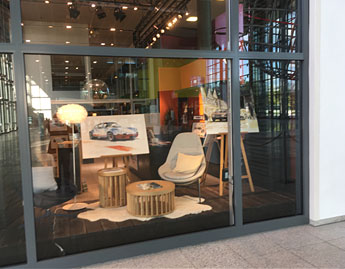
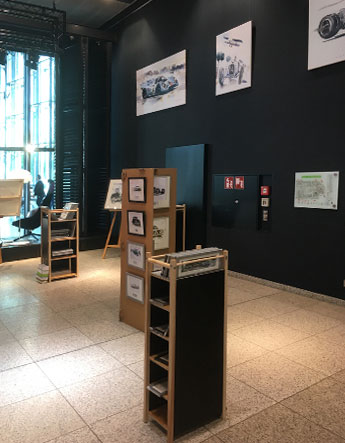
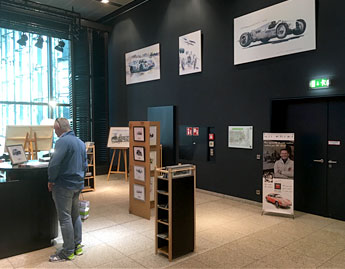
|
Autostadt Wolfsburg Metropol Finest Selection Shop
Ausstellung vom 15. 9. bis 5. 10. 2018 mit Aquarellen von Uli Ehret
Ihr Besuch ist herzlich willkommen! |
#746 Porsche 911 RSR Rothmans #91 LM 24H 2018
#747 Pink Ribbon Porsche Dempsey
#748 Porsche 911
#750 Porsche 911 RSR Pink Pig LeMans 2018 |
All the new latest paintings |
|
See you at Le Mans Classic! Bonjour au Mans Classic! |
|
Nürburgring 1000 km Rennen, 1969
Der Jo Siffert / Brian Redman Porsche 908 führt den spannenden Dreikampf vor dem Ferrari 312P von Chris Amon und Pedro Rodriguez die 1000 km am Nürburgring 1969 an. Gerhard Mitter und Udo Schütz auf dem zweiten Porsche 908 kämpfen zu Beginn mit um die Führung, müssen später aber mit Lagerschaden an der Vorderachse aufgeben. Mit Regen zur Mitte des Rennens macht sich die Grüne Hölle des Nürburgrings erneut einen Namen. Trotzdem war es ein besonderer Tag für die Zuffenhausener Rennwagen: Platz eins bis fünf gehen an Porsche. Der erste Sportwagen-Weltmeistertitel für das Werk ist unter Dach und Fach.
The Jo Siffert/Brian Redman Porsche 908 leads the 1000 km at Nürburgring in 1969. It was an exciting race with the 908 against the 312P of Chris Amon/Ricardo Rodriguez, and Gerhard Mitter/Udo Schültz in the second Porsche 908 at the beginning of the 44 laps. With rain during the middle of the race, the Green Hell again showed its dangerous face. Nevertheless, it was a special day for the Zuffenhausen racing cars. Places one to five went to Porsche. The first sports car world champion title for the German works team.<
La Porsche 908 de Jo Siffert / Brian Redman mène les 1000 km du Nürburgring en 1969. C'était une course excitante, avec la 908 contre la Ferrari 312P de Chris Amon / Ricardo Rodriguez et Gerhard Mitter /Udo Schütz sur la deuxième Porsche 908 au début des 44 tours. Avec la pluie en milieu de course, le « Green Hell » a de nouveau montré son visage dangereux. Néanmoins, ce fut un jour spécial pour les voitures de course de Zuffenhausen: les places 1 à 5 allaient à Porsche. Premier titre de champion du monde de voiture de sport pour l'équipe d´usine allemande |
|
Comet over Palmyra
Die "De Havilland Aircraft Company" hat von 1915 bis 1959 127 Flugzeugtypen gebaut. Herausragend aus der Vielzahl war unter anderem die DH.88 Comet, die zu ihrem Erstflug am 8. September 1934 abhob. Sie wurde speziell für das "Victorian Centenary Air Race" gebaut. Geoffrey de Havilland wollte unbedingt, dass der Sieg des Luftrennens nach Großbritannien ging, und bot in Zeitungsanzeigen an, ein Rennflugzeug für 5000 englische Pfund zu bauen. Das "MacRobertson-Luftrennen", startete am 20. Oktober 1934 – also gerade einmal etwas mehr als 40 Tage nach dem Erstflug der DH.88. Das Luftrennen führte die Teilnehmer von Mildenhall in England bis nach Melbourne in Australien. Der Royal Aero Club legte als Entfernung 18.200 km fest, und offerierte 27 Stützpunkte zur Betriebsstoff-Aufnahme. Für das Rennen mussten teilweise sogar Flugplätze ausgebaut werden. 60.000 Menschen erlebten den Start. Die Teilnehmer und ihre Flugmaschinen kamen überwiegend aus England, Australien und den USA. Jim Mollison & Amy Johnson nahmen in der schwarzen Comet teil – beide bekannte Flieger und Rekordjäger – und damit ein sehr bekanntes Traumpaar des Commonwealth. Die "Black Magic" führte bis Karatschi auch das Rennen an – aber das Traumpaar Mollison-Johnson hatte bei einem unplanmäßigen Halt in Jobbolpore (Indien) und der dortigen Zuführung minderwertigen Benzins, die beiden Flugmotoren und den Traum des Sieges am Luftrennen irreparabel zerstört. An der mit-favorisierten, dreimotorigen Pander S4 "Panderjager" der niederländischen Piloten Geysendorffer, Asjes und Pronk wurde in Allahabad bei der Landung ein Triebwerk zerstört und sie waren damit ebenfalls aus dem Rennen. Die niederländische Douglas DC-2 "Uiver" war über die vier Renntage häufig auf Platz zwei gelegen. Parmentier, Moll, van Brugge und Prins waren in Singapur mit ihrer DC-2 nur etwa acht Stunden hinter der führenden Comet. Am Ende waren es aber mehr als 18 Stunden Vorsprung für die rote Comet DH.88. Die "Grosvenor House" mit C.W.A. Scott und T. Campbell Black erreichte in 71 Stunden als erstes Melbourne und siegte. Gefolgt von der US-amerikanischen Besatzung Turner/Pangborn/Nichols mit ihrer Boeing 247-D, die nach 92 Stunden und 55 min das Ziel sahen.
The De Havilland Aircraft Company built 127 types of aircraft, between 1915 and 1959. Outstanding among the many was the DH 88 Comet, which took off for its maiden flight on 8 September 1934. It had been built especially for the ‚Victorian Centenary Air Race'. Geoffrey de Havilland desperately wanted the trophy to go to the UK, and in newspaper adverts offered to build a race aircraft for £5000. The ‚Victorian Centenary Air Race' or ‚MacRobertson Air Race' started on October 20, 1934 - just over 40 days after the first flight of the DH 88. The air race took the participants from Mildenhall in England to Melbourne in Australia. The Royal Aero Club recorded a distance of 18,200 km and offered 27 resource sites. In some cases airfields even needed to be expanded for the race. 60,000 people experienced the start of the race with the participants and their flying machines coming mainly from England, Australia and the USA. Jim Mollinson & Amy Johnson - both well-known as aviators and record hunters and also the dream couple of the Commonwealth, competed in the black Comet. The ‚Black Magic' led the race to Karachi - but the ‚dream couple' had irreparably destroyed both aircraft engines and their dream of winning the air race during an unscheduled stop in Jobbolpore (India) with the supply of inferior gasoline. The favoured, three engine Pander S4, ‚Panderjager' of the Dutch pilots, Geysendorffer, Asjes and Pronk was destroyed in Allahabad. The Dutch Douglas DC-2 ‚Uiver' was often in second place over the four race days. Parmentier, Moll, van Brugge and Prins were in Singapore with their DC-2 only about eight hours behind the leading Comet. In the end, the DC-2 was more than 18 hours behind the red Comet DH.88 ‚Grosvenor House' with C.W.A. Scott and T. Campbell Black. They reached Melbourne first to win the air race. Followed by the US crew Turner/ Pangborn/ Nichols with their Boeing 247-D, who saw the finish after 92 hours and 55 minutes.
« De Havilland Aircraft Company » a construit des avions entre 1915 et 1959. Le DH.88 Comet, qui a décollé pour son premier vol le 8 septembre 1934, était remarquable. Il a été construit spécialement pour la «Victorian Centenary Air Race». Geoffrey de Havilland voulait désespérément le trophée pour la Grande-Bretagne, et il a offert dans les annonces de journaux qu´il construirait un avion de course pour 5000 livres. La « MacRobertson Air Race », commença le 20 Octobre, 1934 - juste un peu plus de 40 jours après le premier vol de la DH.88. La course aérienne a conduit les participants de Mildenhall en Angleterre à Melbourne en Australie. Le Royal Aero Club a parcouru une distance de 18 200 km et a proposé 27 centres de ressources. Dans certains cas, même les aérodromes ont dû être agrandis pour la course. 60 000 personnes ont été présentes au départ. Les participants et leurs machines volantes venaient principalement d'Angleterre, d'Australie et des États-Unis. Jim Mollison & Amy Johnson a pris part avec leur « Comet » noire - à la fois aviateurs et chasseurs de records, et avec ceci un couple de rêve bien connu du Commonwealth. Le « Black Magic » a également mené la course à Karachi, - mais ils ont perdu leur avion dirèctement après. Une escale non prévue à Jobbolpore (Inde) et l´utilisage de l'essence de qualité inférieure, ont détruit les deux moteurs. Un autre avion favorisée, la Pander S4 « Panderjager » trois moteur avec les pilotes néerlandais Geysendorffer, Asjes et Pronk a été détruit lors de l'atterrissage à Allahabad. Le Néerlandais Douglas DC-2 « Uiver » a souvent été deuxième à la course. Parmentier, Moll, van Brugge et Prins était en deuxième position à Singapour avec leurs DC-2. Seulement environ 8 heures de retard sur le premier avion Comet. Au final, il avait plus de 18 heures de retard sur la Comet rouge DH.88, la "Grosvenor House" avec C.W.A. Scott et T. Campbell Black. Ils ont atteint Melbourne en 71 heures et ont gagné la course. Suivi par les Américains Turner / Pangborn / Nichols avec leur Boeing 247-D, qui ont vu l'arrivée après 92 heures et 55 minutes de vol.
|
|
11 Ore
Herbert Linge und Guido Scagliarini fahren am 24. Mai 1959 mit ihrem Porsche 550 während der Targa Florio durch das Bergdorf Collesano. Mehr als 11 Stunden am Steuer, unter der mediterranen Sonne, über holprige Straßen, können sie den gewonnenen Überlebenskampf für Mensch und Maschine mit dem zweiten Gesamtplatz feiern. Die vier favorisierten Ferrari Testa Rossa fielen über den Renntag einer nach dem anderen dem mörderischen Test der Automobiltechnik zum Opfer. Graf Berghe von Trips und Joakim Bonnier schieden mit ihrem Porsche RSK aus. Auch die Fahrerpaarung Umberto Maglioli – Hans Herrmann musste ihren RSK 718 frühzeitig abstellen. Edgar Barth und Wolfgang Seidel gewannen die Targa Florio 1959 mit einem Schnitt von 91,309 km/h und knapp zwanzig Minuten vor Linge/Scaglarini. Zwei Porsche 356 A Carrera mit ihren 1,6 Liter Motoren folgten - mit Hanstein/Pucci auf dem dritten Platz und Strähle/Mahle auf dem vierten. Der als Fahrzeugdesigner bekannte Piero Drogo erreichte mit Beifahrer Mennato Boffa auf dem Maserati A6 GCS-53 nach 11 Stunden und 41 min das Ziel auf Platz 5.
Herbert Linge and Guido Scagliarini take second place with their Porsche 550 on May 24, during the 1959 Targa Florio. After more than 11 hours at the wheel, under the Mediterranean sun, over bumpy roads, they can celebrate the triumph of their struggle for survival for man and machine, with overall second place. One by one the four favoured Ferrari Testa Rossa fell victim to the murderous test of automotive engineering over that race day. Count Berghe von Trips and Joakim Bonnier also abandoned their Porsche RSK. The driver pairing of Umberto Maglioli - Hans Herrmann also had to park their RSK 718 early. Edgar Barth and Wolfgang Seidel won the Targa Florio in 1959 with an average of 91.309 km/h -twenty minutes ahead of Linge/Scagliarini. The two 356A Carrera with their 1.6 litre engines achieved third place with Hanstein/Pucci and fourth with Strähle/Mahle. Piero Drogo, later well known as a car designer, followed in fifth position, with Mennato Boffa at the wheel of their Maserati A6 GCS-53.
Herbert Linge et Guido Scagliarini prennent la deuxième place avec leur Porsche 550 le 24 mai 1959. Plus de 11 heures au volant, sous le soleil méditerranéen, à travers les villages de montagne, sur les routes cahoteuses, ils peuvent célébrer leur deuxième place après un combat de survie pour l'homme et sa machine. Les quatres Ferrari Testa Rossa favorisées ont été victime d'un test meurtrier de l'ingénierie automobile le jour de la course - l'une après l'autre. Le comte Wolfgang Berghe von Trips et Joakim Bonnier abandonnèrent également avec leur Porsche RSK. Umberto Maglioli – Hans Herrmann ont également dû abandonner plus tôt leur RSK 718.Edgar Barth et Wolfgang Seidel ont remporté le Targa Florio en 1959 avec une moyenne de 91,309 km/h, vingt minutes avant Linge/Scaglar ni. Deux Porsche 356 Carrera avec leurs moteurs de 1,6 litres ont fini avec Hanstein/Pucci en troisième place et avec Strähle/Mahle pour la quatrième. Piero Drogo, connu comme le designer du Maserati 450S « Drogo », pris la cinquième position, avec Mennato Boffa. Ils ont finit l'épreuve après 11 heures et 41 min au volant de leur Maserati A6 GCS-53.
|
|
Norge - Roald Amundsen
Roald Amundsen and an illustrious group of technology ad- venturers flew over the North Pole from Spitsbergen to Teller in Alas- ka in May 1926. With the airship ‚Norge' a human being flew for the first time from Spitsbergen to Alaska, by crossing the Northpole.Umberto Nobile had constructed and built airships in Italy. Riiser- Larsen, another member of the Amundsen group, had completed a British airship flight course and moved Amundsen to buy the N1, Umberto Nobile's airship. Lincoln Ellsworth contributed $ 100,000 to the venture as a sponsor. Thus, the expedition was called the ‚Amund- sen-Ellsworth-Nobile-Transpolar flight'. The Norge was 106 m long, 19m wide and 24m high. It was constructed of reinforced aluminium, the outer shell being made of a rubber-like material. Inside was a balloon filled with 19500 m3 of hydrogen. Below the balloon, mechanics and technicians were able to walk on a centre keel. On March 29 1926, the N1 officially changed ownership and became known as ‚Norge', owned by the Norwegian airline. Meanwhile, in Ny Alesundon, Spitsbergen, a hangar and a mast had been carefully built into the climatically challenging landscape. From there, on May 11 at 9.55 am, the Norge, with 16 men on board, took off for their great flight. On May 12, at 12.25 pm, they reached the North Pole. The direction of the onward flight to Alaska, would now be over completely unknown and unexplored territory. Flying through dense fog prevented the exploration of the country and brought numerous problems caused by icy propellers and chunks of ice, which were hurled against the shell by the rotation of the propellers. Continual repairs, whilst flying, were carried out to avoid the risk of damage to the shell and its construction. By 6 o'clock in the morning on May 13, they were probably not far from the Siberian coast at the Cape of Serdze Kamen. A strong wind had driven them westward over the Bering Sea. By 11 o'clock that same day, they were back on track for Alaska when a storm forced them to again drift sideways. As they passed over the Cape Prince of Wales they were again driven back and forth by the strong wind. Although they now did not know where they were, they decided to land as soon as possible. They chose an icy bay as a landing spot, near the small settlement of Teller in Alaska, 150 km northwest of Nome. They had spent 72 hours in the air. All participants returned to their home countries and were celebrated as heroes.
En mai 1926, Roald Amundsen et un groupe d'aventuriers et de techniciens survolèrent le pôle Nord de Spitzberg à Tellers, en Alaska. Avec le dirigeable « Norge », un être humain vola pour la première fois de Spitzberg jusqu'en Alaska en franchissant le pôle Nord. Umberto Nobile avait construit des dirigeables en Italie à cette époque. Riiser-Larsen, un autre membre du groupe Amundsen, a suivi un cours de pilotage de dirigeable en Angleterre et a proposé à Amundsen d'acheter le N1, le dirigeable d'Umberto Nobile. Lincoln Ellsworth a versé 100 000 dollars à l'entreprise en tant que sponsor. Ainsi, l'expédition correspond au « Amundsen-Ellsworth-Nobile-Transpole-Flight ». La Norge mesurait 106 mètres de long, 19 mètres de large et 24 mètres de haut. Il était construit en aluminium renforcé, la coque extérieure était en caoutchouc. Dans ce ballon se trouvait un deuxième ballon rempli de 19500 m3 d'hydrogène. Sous le ballon d´hydrogène, les mécaniciens et les techniciens pouvaient marcher sur une quille centrale. Le 29 mars 1926, le N1 change officiellement de nom et devient «Norge», propriété de la compagnie aérienne norvégienne. Pendant ce temps, à Ny Alesund, sur Spitzberg, un hangar et un mât avaient été minutieusement intégrés pour faire face à un climat difficile. De là, le 11 mai à 21 h 55, le Norge avec ses 16 hommes à bord décollait pour son grand vol. Le 12 mai à 12h25, ils ont atteint le pôle Nord. Le vol en direction de l'Alaska était maintenant un pays totalement inconnu et inexploré. Les réparations en cours de route ont été effectuées en permanence pour éviter les risques de dommages de la coque et de sa construction. Le 13 mai, à 6 heures du matin, ils n'étaient probablement pas loin de la côte sibérienne au cap Serdze Kamen. Un vent fort soufflait vers l'ouest sur la mer de Béring. Le même jour, à 11 heures, ils étaient de nouveau sur la bonne voie en Alaska quand ils dérivèrent à nouveau. Ils ont dépassé le cap Prince Wales lorsqu'ils ont été chassés à nouveau par le vent violent. Bien qu'ils ne savaient pas exactement où ils se trouvaient, ils décidèrent d'atterrir le plus tôt possible. Ils ont choisi la baie glacée comme point d'atterrissage, près du petit village de Teller en Alaska, à 150 km au nord-ouest de Nome. Ils ont passé 72 heures dans l´air. Tous les participants sont rentrés dans leurs pays et ont été célébrés comme des héros.
|
|
Farman Goliath
Am 8. und 9. Februar 1919 wagt der Pilot Lucien Bossoutrot mit seinem Mechaniker Lhomde und zwölf britischen Militärangehörigen den Erstflug eines kommerziellen Passagierflugzeugs von Toussus-le-Noble bei Paris nach Kenley bei London. Der "Airbus" Farman Goliath startet am 8. Februar 1919 um 11.50 Uhr. Er kommt zwei Stunden und 30 Minuten später sicher in Kenley bei Croydon in England an. Der Prototyp des FF-60 machte seinen ersten Flug ohne Passagiere bereits Ende Oktober 1918. Die Deutsche Kapitulation am 7. November 1918 machte allerdings die Bestellung eines schweren Bombers bei Farman durch die Französische Luftwaffe hinfällig. In Billancourt bei Farman, wo die Goliath Flugzeuge zusammengebaut werden, wird die Produktion sofort auf den Einsatz als kommerzielles Flugzeug umgestellt – die Geburtsstunde der kommerziellen Luftfahrt. Der Goliath "Airbus" von Farman, wird im Dezember 1918 in der französischen Zeitschrift "L´Aerophile" durch Ernest Archdeacon wie folgt vorgestellt: "Die Fahrgastgondel ist, mit Ausnahme des Ausstiegs zum erhöhten Steuersitz des Piloten, wie eine elegante, vollkommen geschlossene Lounge geformt. Sie ist mit komfortablen, leichten Korbsesseln ausgestattet. Ihre Form einer langen Zigarre, die groß und weit wirkt, wird durch die Nutzung großer, stabiler Fensterscheiben vom Licht durchflutet. Die Passagiere verpassen nichts von der atemberaubenden Sicht auf die Landschaft, die sich vor ihren Augen ausbreitet.
On 8 and 9 February 1919, the pilot, Lucien Bossoutrot, with his mechanic Lhomde and 12 British military personnel, attempted the first flight of a commercial passenger plane from Toussus-le-Noble, near Paris, to Kenley, near London. The ‚Airbus' Farman Goliath took off on 8 February 1919, at 11.50 am. He arrived safely at Kenley, Croydon, in England, two hours thirty minutes later. The prototype of the FF - 60 made its first flight without passengers at the end of October 1918. The German capitulation on November 7 1918, however, made the appointment of a heavy bomber at Farman to the French Airforce, obsolete. At Billancourt, near Farman, where the Goliath aircraft were assembled, production was immediately switched to commercial aircraft - the birth of commercial aviation. The Goliath ‚Airbus' by Farman, was introduced in December 1918 in the French magazine ‚L'Aerophile' by Ernest Archdeacon as follows: "The passenger gondola is, with the exception of the exit to the pilot's elevated control seat, an elegant, completely closed lounge shape. It is equipped with comfortable, lightweight wicker armchairs. Its shape of a long cigar looks big and wide, is flooded with light through the use of large, sturdy windows. Passengers do not miss the breathtaking view of the landscape that unfolds before their eyes."
Les 8 et 9 février 1919, le pilote Lucien Bossoutrot, accompagné de son mécanicien Lhomde et de douze militaires britanniques, entreprit le premier vol d'un avion de ligne commercial entre Toussus-le-Noble près de Paris et Kenley près de Londres. L' «Airbus» Farman Goliath commence le 8 février 1919 à 11h50. Il arrive en toute sécurité chez Kenley à Croydon en Angleterre deux heures et demie plus tard. Le prototype du FF-60 effectua son premier vol sans passagers fin octobre 1918. La capitulation allemande du 7 novembre 1918 rendit toutefois obsolète la nomination d'un bombardier lourd à Farman par l'armée de l'air française. À Billancourt, près de Farman, où les avions Goliath sont assemblés, la production est immédiatement basculée sur des avions commerciaux - la naissance de l'aviation commerciale. L' « Airbus » Goliath de Farman, présenté en décembre 1918 dans le magazine français « L'Aerophile » d'Ernest Archdeacon, était libellé comme suit: La télécabine pour passagers est, à l'exception de la sortie sur le siège du pilote surélevé du pilote, en forme. Il est équipé de fauteuils en osier confortables et légers. La forme d'un long cigare qui semble grand et large est inondée de lumière grâce à l'utilisation de grandes fenêtres robustes. Les passagers ne manquent pas la vue imprenable sur le paysage qui se dévoile sous leurs yeux.
|
|
Solitude Bleu Foncé
Francis Navarro und Jean de Montremy auf einem Monopole X88 Sport mit einem Panhard 750 ccm Motor trotzen im Nachttraining des 24 Stundenrennens der Dunkelheit und Einsamkeit auf der baumbestandenen, ultralangen geraden von Le Mans.
|
|
L´Atterrissage sur le Mont Blanc
Mit der Landung des Schweizers Francois Durafour am 30. Juli 1921 mit seiner französischen Caudron G-3 auf dem Rücken des Col du Dome, unterhalb der Spitze des Mont Blanc Massivs, war ein herausragender Höhenflug dieser Epoche gelungen. Die Landung und der Rückflug gelangen mit Hilfe von Alpinisten, die im Sommer 1921 vor Ort waren.
The landing of Swiss, Francois Durafour on July 30, 1921 with his French airplane, a Caudron G-3 to the back of the Col du Dome, below the top of the Mont Blanc Massif, was an outstanding moment in aviation from this era. The landing and the return flight only occurred with the help of alpinists, who were on site in the summer of 1921.
Le débarquement du Suisse Francois Durafour le 30 juillet 1921 avec son avion français Caudron G-
|



|
Autostadt Wolfsburg Metropol Finest Selection Shop
Ausstellung vom 15. 9. bis 5. 10. 2018 mit Aquarellen von Uli Ehret
Ihr Besuch ist herzlich willkommen! |
#746 Porsche 911 RSR Rothmans #91 LM 24H 2018
#747 Pink Ribbon Porsche Dempsey
#748 Porsche 911
#750 Porsche 911 RSR Pink Pig LeMans 2018 |
All the new latest paintings |
|
See you at Le Mans Classic! Bonjour au Mans Classic! |
#730 BMW M8 GTE Team MTEK
#729 Aston Martin Vantage
#731 SMP Racing LM 2018
#732 Ford Chip Ganassi Team
#733 Rebellion Racing
#734 Porsche 911 RSR
#735 Porsche 911 GT3 R
#715 Grello Manthey Porsche
#716 Knight & Day
#717 Mercedes AMG GT3
#718 Sieg Audi 24H Nürburgring |
Merci Nürburgring 24 Stunden! Bonjour Le Mans 24 Henres! All the new latest paintings |
|
Welcome à Strasbourg! Visitez Uli Ehret! Stand B18, Hall 7, 28e Avril à 1er Mai, Expo Strasbourg |
|
See you at the Hockenheim Historic in April! See you at the 24h of Nürburgring! |
|
See you at the Retromobil at Paris! 07. - 11. February 2018, Hall 1, Galerie des Artistes
|
#697 MZ 250 |
Dear Friends and Collectors! The next few months will be mostly spent painting. This is one of the projects I always had in mind: One of the Motorenwerke Zschopau racers from legendary racing team from Eastern Germany. Here we see Derek Woodman in action on a MZ 250.
|
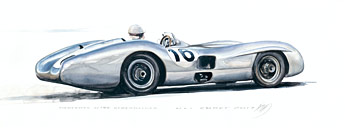
#694 Mercedes W196 Streamliner
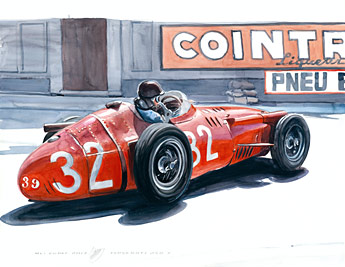
#693 Maserati 250F
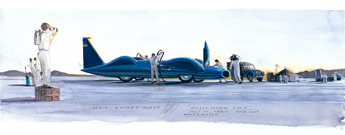
#692 Bluebird CN7
#691 "Highnoon at Le Mans"
#689 "A Sunny Morning"
#688 Porsche 919 & 991RSR
#687 ByKolles, Le Mans 2017
|
New Original Paintings ! After a great event at Chichester/Sussex, the Goodwood Revival Uli is back for the autumn and winter time in his gallery.
Please visit us at Weinheim for a wonderful Espresso and a petrolhead chat.
Find the latest paintings at our gallery walls in Weinheim/ Southern Germany.
We are open Monday to Friday 8 a.m. to 5 p.m. and on the saturday after request (Please call 0049 (0)1522 1521 427).
Welcome to Weinheim!
|
|
|
ZÜNDFUNKEN & GEISTESBLITZE Besondere Menschen und Ihr Einfluss auf die Geschichte des Automobils.
Aquarelle von Uli Ehret, Erläutert durch Zitate automobiler Zeitgenossen.
Ausstellung im Audi Forum Neckarsulm vom 15. Juli bis 31. August 2017.
Es erwartet Sie am 15. Juli ein exquisiter Tag in einem der herausragendsten Gebäude Baden-Württembergs. Mit 20 großen Exponaten stellt Uli Ehret Zeitgeschichte deutscher Automobilisten dar.
Die Heidelberg Historic macht an diesem Tag Halt im Audi Forum Neckarsulm. Es erwarten sie mehr als 200 Oldtimer und Sportwagen, ja sogar mancher Renn- und Rallyewagen.
Uli Ehret malt an diesem Tag live eine NSU Fox.
Den Inbegriff der Mobilität der 50er Jahre.
Aber nicht irgendeine NSU Fox, sondern die von Herbert Linge selbst restaurierte.
Herzlich willkommen zu einem schönen Tag in Neckarsulm. |
|
Book Volume V - Le Mans Passion
#683
#680
#679
#678
#677
#676
#675
#674
#673 |
The highlight of the racing year: the 24 Hours of Le Mans! Please visit our stand in the heart of the track in the village central.
We are open tuesday to sunday and show 15 new original paintings!
Also there is a new book about Uli´s Le Mans paintings, illustrated with words of
48 Le Mans pilots and team managers, mechanics and heroes,
texts by Stephen Bradford Best. |
#669
#670
#671
#672 |
Le Mans 2017 is coming! Porsche 919 at Mulsanne... c u in 44 days ! |
#648
#660
#661
#663
#664 |
New Paintings ! Dear friends and collectors. After a few months of intensive work on my painters desk you will find a number of new paintings here.
I am looking forward to seeing you in 2017 at Hockenheim Historic in April, the 24 Hours of Le Mans in June and the Goodwood Revival in September! |
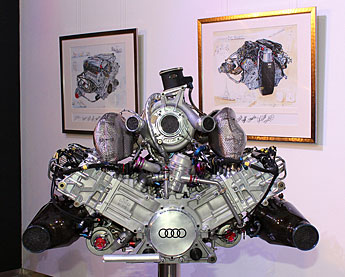
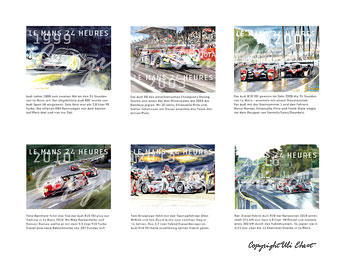 |
Audi Night at the Museum Sinsheim With Dr. Ulrich Baretzky as the guest of the evening, the ´Audi at Le Mans night´ in the Auto & Technik Museum Sinsheim was spot on. 150 guests from the motorsport industry, friends of the museum and of the moderator of the evening and motorsport artist Uli Ehret enjoyed three hours with champagne and excellent food and background stories to the 14 victories in 17 years of Audis and Bentleys presence at Le Mans. The main part of the evening was the chat of Ulrich Baretzky and Uli Ehret. With fascinating stories told live by the head of engine development of Audi for the last 20 years. Baretzky entertained the guests with his experience and humour, but most of all with his background race stories about Audis 17 Le Mans participations. Uli Ehret showed the four engine paintings with Audis R8, R10, R15 and R18 engines which he painted for Baretzkys team, but also seven extralarge posters which show Audis race cars at speed and in the action of pit stops and the night at the Sarthe. A special painting was offered to the guests - a limited edition of 24 reproductions of Audis top cars and winners at Le Mans. A few of the 30 x 40 cm large framed reproductions are still available.
Die Ausstellung im Auto & Technik Museum Sinsheim wird bis August 2017 für die Öffentlichkeit täglich zugänglich sein. Weitere Informationen finden Sie unter www.technik-museum.de |
See you at the Ring ! The WEC series is racing at the famous Nürburgring this weekend. Another great race ahead in LMP1 and GTE.
Have a great summer, wherever you race ! |

